Autobiography: Sylvia Louise Engdahl
This appeared, with many of the pictures, in Contemporary Authors, Vol. 195, Gale, 2001 and Something About the Author, Vol. 122, Gale, 2001. The part of it prior to the Postscript section was originally published in Something About the Author Autobiography Series, Vol. 5, Gale, 1988.
*
As far back as I can remember I felt different from people around me. Perhaps that was one reason I chose to write about other worlds. It was not the main one—mainly I write about them because I believe the humanization of space is vitally important to the future of our species. But before talking about my books, I should tell something about my life.
I was born and grew up in Los Angeles, California, which is a place I never have liked and do not recall with nostalgia. My father, born in 1881, came to America from Sweden as a small child, but he had forgotten his Swedish heritage at the time I knew him and had no living relatives except a grown son and granddaughter from a previous marriage. He was a real estate salesman, only occasionally successful. My mother came from New England, and my grandmother, her mother, lived with us during most of my youth. I had no brothers or sisters other than my half brother, whom I seldom saw and thought of as an uncle. A second cousin, ten years older than I, was the one relative outside my immediate family that I knew well.
I never had anything in common with other children and didn’t enjoy playing with them. My mother tells me I was a happy child so I must have seemed outwardly content, but I don’t remember being happy often. On the other hand, I was rarely especially unhappy, either. I simply waited, in a sort of resigned way, to grow up, assuming that in the adult world life would really begin. It didn’t turn out like that, of course, but I have done quite a few interesting things as an adult, whereas not much of interest happened during my school years.
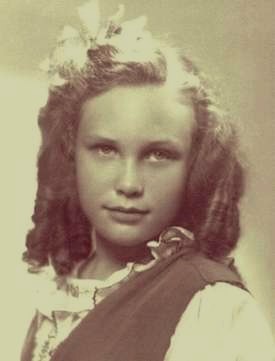
Sylvia Engdahl at age ten, 1943
I was bored by school. What I learned, I learned at home from my mother and from reading; school was mainly hours to live through, punctuated by moments of fierce anger at teachers who wanted me to participate in active games not only during Phys Ed periods, which I despised, but during recess. This I considered (and still consider, despite today’s faddish idolization of “fitness”) an intolerable injustice—I can remember hiding in the girls’ room to get out of it. At that time it was thought very important to keep children who were poor readers and yet manually skilled from feeling inferior. The reverse, alas, was not true. I got no recognition for superior reading and writing ability, but all too much for my deficiency of physical coordination (I was the only child in kindergarten who couldn’t skip) and my total lack of interest in physical activities, which arose in part from an inborn lack of energy that made all such activities exhausting for me. I did not feel inferior on this account, but I was given the impression that I ought to, and perhaps as a result learned very early to ignore the opinions of so-called authorities in other areas, too. I was never openly rebellious except in refusing to play ball games and to socialize with my peers; certainly I never told teachers or classmates that my views on most subjects didn’t match those of society. But my inner convictions were always my own.
Outside school I had little companionship apart from that of my mother, who was, and remains, the chief personal influence on my life. Our tastes were similar, though as I grew up my specific interests became very different from hers. Mother, who had been an English teacher and a little theater director, fostered my innate enthusiasm for reading, writing, and the world of ideas. Her marriage was an unhappy one, for my father liked none of these things (I cannot remember his ever opening a book or magazine) and she thus turned to me, much as I turned to her because I found no friends of my own age with compatible interests. Neither of us had any domestic inclinations; Mother kept house only because at the time she had no alternative. Had she told me when I was small that she disliked it, I would have helped more with the housework, but she made the mistake of trying to persuade me to learn such skills for my own future good, and I reacted against that right from the beginning. I had no desire to marry, raise children, or be a homemaker, though in those days it was assumed that a girl “naturally” would—and unlike my mother, I didn’t believe one should do things merely because they were expected. When I was older I envisioned someday marrying for love, but the sad example of my parents’ marriage had put me on guard against falling in love with anyone who did not share my intellectual interests and who had none of his own that I could admire. This, I believe, was fortunate, since I might otherwise have plunged rashly into a conventional life for which I was not at all suited.
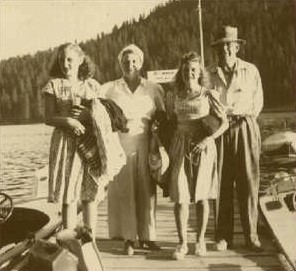
With parents and cousin at Bass Lake, 1946
The highlights of my younger years were our short summer vacations at Bass Lake, north of Los Angeles in the Sierra Nevada. We went there for the first time when I was ten, and ever since I’ve dated the beginning of my life from that trip; no earlier memory has any meaning for me. When I saw Bass Lake, I realized what was missing in Southern California, which I’d hitherto taken for granted. At Bass Lake trees cloaked the mountains and shoreline—forest trees, in this case Ponderosa pines, very unlike the cultivated trees found in Los Angeles. There was green forest undergrowth and clear, fresh air. And of course, there was the water. We rented a boat that first year; later on my father bought one, the only thing he ever did that I found enjoyable. I counted the days between our trips to Bass Lake, and during my teen years I was convinced that nothing could make me happier than to live there permanently. I even hoped I might someday get a job teaching the one-room school there.
I planned from earliest childhood to be a teacher. Even when I was so young as to enjoy dolls, I always imagined myself as “teacher” rather than “mother,” and by the time I was eleven I was running a Saturday morning “nursery school” for neighborhood children. During my early teens I organized summer arts and craft classes through which I earned some spending money. What I really enjoyed was planning and being in charge, not the actual contact with children; but I was too young to realize that. Anyway, I preferred it to social contact with my agemates, of which I had little because I could not share the interests of other teens.
If I were a teenager today, it would be different. Today many teenagers are interested in computers, and I often think of what a social life I’d have had if I had grown up in such an era. When I phone electronic bulletin boards used largely by teens, I am reminded that had these existed during my own youth I would not have been isolated and lonely. In addition to having a natural bent for programming, I communicate better via a keyboard than in person, and would have done so even in adolescence. At that time it was assumed, even by me, that I could not talk because I was shy; but now I know that it was the other way around. I was shy because I could not talk easily, and I could not do so because I need visual feedback rather than audible feedback when expressing my ideas. I am a natural writer, and today natural writers are coming into their own socially via electronic mail and interactive computer conferencing. But of course, when I was in my teens, no one had heard of computers at all, let alone home computers.
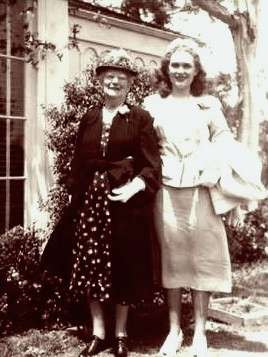
With grandmother Sarah Louise Butler, 1948
So high school, like the earlier period, was merely a time of waiting for me. I kept busy with my own pursuits but had as little to do with school as possible. I didn’t get particularly high grades because the classes didn’t seem worth bothering with, and also because teachers often marked down students who didn’t talk effectively, however well they did on written work. Still I met the requirements for graduation easily enough, and in fact met them in time to graduate a semester ahead of schedule—but the counselor wouldn’t let me do it because I was “too young” and not “socially mature,” by which she meant she thought I ought to participate in class activities. As usual, I was silently resentful, and not as assertive in fighting that decision as I now feel I should have been. I was indeed young, barely sixteen, but ironically most of my few friends happened to be in the class ahead. They graduated, while I was forced to remain without any classes of substance left to take (I hadn’t been permitted to enroll in physics because I didn’t plan a science major in college). I repeated Library Practice, which I enjoyed, and signed up for the class that produced the yearbook, ending up as Assistant Editor; I suppose this looked good on my record but it did not really involve much editing work .
The one school incident with lasting influence on my life happened when I was twelve, in a ninth-grade science class. It was there that I first heard about space. We were studying astronomy, which for a while captured my imagination; but more significantly, one day the teacher read aloud a short description of what it might be like to travel in space, and for some reason it excited me in a way nothing else ever had. I had not read any science fiction, and had never talked to anyone who knew of it; and of course this was in 1946, before space travel was widely discussed. Yet I went home that day and began drawing pictures of rockets on the way to Mars. A friend happened to be with me; I said to her—on the basis of no information or reading whatsoever—that I was willing to bet a spaceship would reach the moon within twenty-five years. As it turned out, I was just two years off, on the conservative side, in my wild estimate. I will never know what prompted it.
From then on I read whatever I could find about space, though I did not care for much of the science fiction I encountered. I was interested in what space travel and colonization of other planets might actually be like, not in wild adventure tales or stories designed to be as exotic and far-removed from real life as possible—and for this reason, I still don’t consider myself a “science fiction fan.” I honestly don’t know why space fascinated me in those early years. It was before I had developed the convictions about its importance that have been so central to me since, and though it may seem as if, being a social misfit, I might understandably have daydreamed about some better world, that was not what happened. I didn’t imagine alien societies. I simply thought about man’s coming exploration of nearby planets. It never occurred to me to doubt that space travel would come.
*
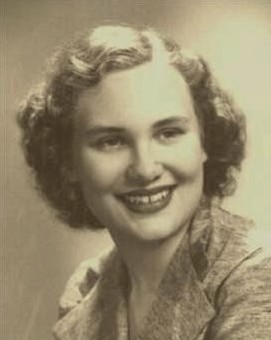
Sylvia Engdahl at age sixteen, 1950
The year I was sixteen, my life changed radically. My parents finally separated, and after I graduated from high school our house was sold; I moved with my mother and grandmother into an apartment while waiting for college to start in the fall. All these events were welcome. I had everything I thought I wanted—I had been accepted by Pomona College in Claremont, California, which I’d long planned to attend, deliberately avoiding the large universities to which other members of my class applied. I hated big cities, and Pomona seemed ideal. When I got there, however, I met exactly the same problems I’d had in high school: classes that were uninspiring and no social life of a kind that appealed to me. Furthermore, I found the company of dorm residents less congenial than that of my mother and the lack of privacy burdensome. I don’t know what would have happened if I’d stayed. A further change, however, drove any thought of staying from my mind. My mother decided to get a master’s degree in drama at the University of Oregon in Eugene. We went for a preliminary visit there during Christmas vacation, and after one look at Oregon I knew that under no circumstances would I be willing to be left behind in Southern California.
It seems strange to me now that I did not immediately enroll in the University of Oregon myself; but we still felt—probably because Mother was a Wellesley graduate—that a small private college would have advantages, and though we didn’t have much money, my grandmother had planned to pay my tuition. So I transferred to Reed College in Portland for the spring semester of my freshman year. When I didn’t fit in there, either, we belatedly realized that for both financial and personal reasons I would be better off in Eugene. My sophomore year, I did attend the U of O. We lived in a small old-fashioned rented house on a tree-lined street near the campus; I still think of it with longing, though we have had many nicer homes since. It was different from anything I’d known in California, and in my eyes much to be preferred. I loved Oregon; I loved the tall firs and the greenness and the change of seasons, and even the steady soft rain. Then too, I was seventeen, and had left childhood and its scenes behind without yet having met any disillusionments of maturity.
This interlude couldn’t last. Mother’s degree program took only a year and a half, and there was nothing for her to do in Eugene afterwards. I didn’t want to live in a dormitory despite my liking for the campus—which had turned out to be the best thing about the U of O from my standpoint. Then too, at that time no elementary teaching certificate was offered there, and I still believed I wanted to teach; so it was necessary to transfer again for my junior and senior years in any case. Mother planned to return to Los Angeles with my grandmother (who remained with us through all our moves until she died in 1965 at the age of 101). I was unwilling to go there, so I chose the nearby University of California at Santa Barbara, in part because it was the only place I could get a B.A. without foreign language courses, and whereas I’d been good at reading and writing languages in high school, my strongly visual mode of expression made me incapable of learning to speak them.
When at the beginning of my junior year we got back from a summer in the East, my father having died in the meantime, Mother decided to come to Santa Barbara too and start a theater group for children. We lived there two years. But after all my transfers I needed longer than that to get the required credits for a degree and teaching certificate. Mother was offered a directing job at the Portland Civic Theater—which, incidentally, she had directed long before in 1927–29—and I could not escape staying behind to finish up. I roomed off-campus, counting the days till I’d be in Oregon again. Fortunately I was able to visit during the winter to interview for teaching jobs, and managed to obtain one in the Portland area for the following fall.

Canoe trip on Lake Coeur d'Alene, 1954
All this time, I had remained firm in my conviction that teaching was the career I wanted, perhaps because I could think of no other, and also because I wanted the summers free for camp work. Summers had been the high spot of my college years, just as Bass Lake had highlighted the earlier era; I had worked as a camp counselor my first year in Oregon, and later in New York State, California, and best of all at Camp Sweyolakan on Coeur d’Alene Lake in Idaho, where I was a Unit Director during the summers of 1954 and 1955. [See Memories of Sweyolakan at this site, with three pages of pictures.] Aside from its beauty, Sweyolakan was particularly enjoyable because I had opportunity to go on canoe trips—though my lack of physical energy kept me from doing much hiking at any of the camps and I spent my time teaching handcrafts and planning campfire programs, I found that paddling was far less tiring for me than walking. I will always cherish the memory of those trips on the water. Also, I liked organizing camp life, and dreamed of someday directing a camp of my own. The fact that being with children was becoming more and more nerve-wearing somehow escaped my attention.
When I found myself at last a fourth-grade teacher in a Portland suburb, however, my temperamental unfitness for the job became all too apparent. It was a disaster. I could tutor the children effectively on an individual basis, but I could not cope with them as a group, nor could I handle classroom discipline. As a matter of fact, I was asked to resign after the first year; but nothing could have induced me to continue in any case. I discovered that I really didn’t like young children, even apart from the fact that I violently disagreed with the theories of education and psychology then in vogue: a fact that had made my college training merely something to be endured for the sake of the required certificate.
So I didn’t know what to do. We had acquired a lovely old house on a hilltop in Portland where I was determined to remain, yet I had to earn a living, and I was not qualified for any job outside the field of education. I knew I could never teach at the high school or college level because I could not express ideas effectively aloud, and anyway I didn’t want to specialize in a particular subject. I would have liked to be a librarian, but that would have meant two more years of expensive college training outside the state of Oregon, which did not offer a librarianship program. I couldn’t do clerical work since my poor physical coordination made it impossible for me to type by the touch system (I still, after many years as a writer, use only two fingers on each hand in typing, which does not bother me but means I can’t attain a typist’s speed). By default, therefore—after a summer as Resident Camp Director at a Camp Fire Girls camp nearby—I began to work toward a Master of Education degree through night courses available in Portland, thinking this would enable me to become a school counselor.
Strangely, the year I spent on that graduate work proved one of the most fruitful of my life. The courses, which demanded little study, were even less inspiring than undergraduate Education courses; but they left me with a great many free hours at home, and for the first time I devoted deep thought to my ideas about space. Furthermore, I began to write them down. Unlike most authors, I had never written stories during my youth, other than a few unpublishable pieces of children’s fiction about such things as Bass Lake and camp life. My creative ideas were abstract intellectual ones, not incidents for stories. It had never occurred to me to become a writer because I knew people didn’t want to read philosophical tracts. But that one year, for reasons I still haven’t been able to decipher, I did get ideas for stories, albeit stories of a quite offbeat sort that were not then marketable. Partial drafts of those that ultimately became my novels were all written then—and I haven’t had an idea for a real story since! I only hope it will someday happen again.
Also during that year, I developed my beliefs about the importance of space to human survival; and that, of course, is something I’ve had a great many more ideas about since. I am by nature more of an analytical person than a storyteller. I can write endlessly about speculations concerning not only space but other subjects; but to express these in story form requires more than writing skill. It demands ideas not just about truths but about happenings. It demands not merely portrayal of characters, but the ability to visualize action in which those characters are involved—and that type of creativeness is not something that can be learned. Most writers have plenty of it; it’s a faculty they start out with and must learn to channel. I, as in so many areas of life, am the opposite of most others; the analytical skills, those taught in writing courses, came naturally to me, but the story-creation faculty has arisen in me rarely.
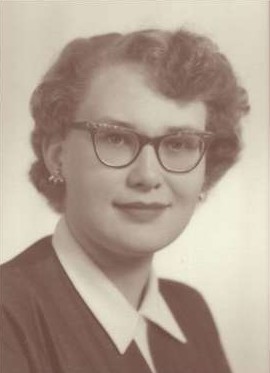
College senior portrait, 1954
I did try to put some of my ideas into short-story form that year of 1956–57, but they were not suitable for short stories and were of course rejected by the magazines to which I sent them. I never thought of making novels of them then. At that time such novels would not have been publishable; space was not yet a topic of general interest.
Among these stories was the one that later became The Far Side of Evil, based on the concept of the Critical Stage about which I was (and still am) entirely serious. Young people today may believe that worry about nuclear war is new, but it isn’t—in 1956 it was a major concern. I thought to myself then, and attempted to say in the story, that planet Earth was indeed in a Critical Stage, that if we didn’t turn our attention to space soon we would very likely be wiped out by a nuclear war. I saw no signs, unfortunately, that we were making any attempt to get into space. One of the most encouraging experiences I’ve ever had was hearing the very next year that Sputnik had been launched into orbit, making it impossible, I believed, for the setting of my story to be Earth. I still believed this when the novel was published in 1971; I assumed after the Apollo moon landing that Earth was fully committed and thus safely past the crisis. Now I am not so sure. Now I am nervous again when I see cutbacks in the space program, since evidently a planet can stay in the Critical Stage much longer than I first thought.
*
In the spring of 1957, nearing the end of my graduate work and without hope of earning money through writing, I came to another turning point. I did not really want to be a school counselor, but I’d been putting off thinking about that problem. I had to go to summer school in Eugene in order to qualify for the degree. One day in May—the most fateful day of my life—I drove down to Eugene from Portland to make the arrangements. I talked to one of the professors there. And some casual remark I made suddenly opened my eyes to the futility of the whole plan. I was, I saw, a hypocrite! I was pretending to believe the officially-approved theories of Educational Psychology when I privately thought they were rubbish, and sooner or later I would be found out. Even if I went on pretending long enough to receive a degree in the field, I would despise working in it. To continue would be intolerable.
I barely managed to conclude the conversation with the professor, then, without registering for summer school, I numbly drove the 125 miles back to Portland. At home, not knowing what to do next, I picked up the nearest magazine and glanced through it; it was Mother’s Wellesley alumnae magazine, something I never read. In it was an article about a young woman who was learning to program computers, which I skimmed with some interest, but did not connect in any way with everyday life—I’d heard of computers, I suppose, in science fiction, but didn’t imagine that people not trained as scientists could experiment with them. Next, I picked up the want-ad section of the newspaper. I’d never looked at that before either, since jobs in the education field aren’t listed in classified ads. To my amazement, there was a box ad there for people to join the same computer programming project mentioned in the magazine article.
The project was the SAGE Air Defense System, then a new and unique concept, which was being developed by the Rand Corporation. Its recruiter was touring the country, stopping in Portland just that one day. The ad appeared in the paper that day only; I will never stop marveling at the uncanny series of coincidences that caused me to see it.
The qualifications mentioned in the ad were not too far from mine; more math courses than I’d taken were specified, but I had done well in math and thought it might be possible to catch up on my own. The listing appeared under “Help Wanted—Men” (in those days newspapers separated jobs by sex) but the magazine article had told me women were included. So I called the recruiter. They did hire women, he said, but his interview schedule was filled; I would have to go to see him late that night at his hotel. Dubious as this might otherwise have sounded, having read about the work in the Wellesley Magazine convinced me that it was legitimate, and so I went. When I got there, he gave me a written aptitude test, then asked me to return for a second interview the next morning. And that morning I was hired on the spot. He told me he’d have accepted me the night before except that it was so obviously a sudden move on my part that he wanted me to think it over.
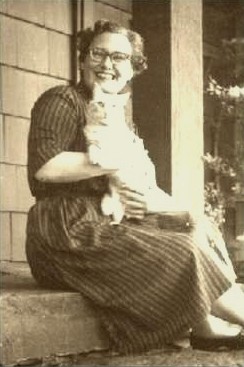
With our cat Butterscotch, 1956
I didn’t have to think long; I was twenty-three years old with no other prospect of employment, and though I had little idea what computer programming was, it sounded interesting. To be sure, it meant leaving Oregon, but my sorrow over that was overshadowed by the excitement of doing something entirely new. Also the salary offered me was astonishing—$400 a month, which in that era, by my standards, seemed like a fortune; it was far more than I had earned as a teacher. I later learned that many of the people hired for the project were former teachers. Now, computer programmers are trained in college; but there was no such thing as a college Computer Science department then. There were no programmers at all except a few mathematicians doing developmental work. SAGE was a large project and its staff had to be found among men and women with degrees in other fields. Our training was provided on the job.
At the end of June, 1957, I reported for work at Rand’s SAGE headquarters in Lexington, Massachusetts. Since this was to be a temporary location and I had no idea where I’d be sent next—we were to be moved around the country to install the system at different Air Force bases—I rented a room in a private home; the most convenient location proved to be in Wellesley Hills, where Mother had lived many years before. The initial phase of training, to my surprise, was a formal course given by IBM on the MIT campus in Cambridge. I was nervous the first day, since I didn’t have all the math prerequisites I’d been told would be expected, but it turned out that no math at all was needed. (Most kinds of programming do not involve mathematics; they’d specified math background only because people with math aptitude are likely to also have programming aptitude.) I found programming easy and loved it right from the start. How strange it seemed to be paid a salary for attending a class much more interesting than any I’d had in college! My free time was filled with more activities than in the past, too, since I had a car, a whole new region of the country to explore, and classmates to take trips with on weekends. That summer was one of the happiest of my life.
I’ll never forget my first look at the computer. Computers in those days were not at all like what they are today—the one used for SAGE, the IBM ANFS-Q7 (called simply the Q7 for short) filled several rooms. In Lexington we had access only to an experimental prototype located at MIT’s Lincoln Laboratory. Since a great many people had to share it besides trainees, our brief computer time during the course was scheduled at three o’clock in the morning. Our government security clearances hadn’t come through yet, so we had to wait in a locked classroom while pairs of students were escorted to the computer room to try out short programs. These programs were of course written in assembly language, the only computer language that yet existed for non-mathematical applications (besides binary machine language, which we also learned). The Q7 didn’t have a keyboard as personal computers now do; to communicate with it, you had to put a deck of punched cards into the card reader. Then, after the program was assembled, you got a deck of binary cards out of the automatic punch machine and put them into the card reader in turn. In later years these operations became very familiar to me, though later, we used magnetic tape rather than cards for most program assemblies. But that first night it all seemed mysterious and exciting.

Front panel of the SAGE computer
To modern computer users it might seem mysterious still, for the Q7 had a room-wide “front panel” of flashing lights. If you knew machine language, you could read the contents of CPU and memory registers in these lights; that’s how debugging was done. The computer room was dimly lit so the lights could be easily seen; the adjacent room containing consoles with air defense displays was called the Blue Room because its dim light was blue. There were still more rooms filled with frames of vacuum tubes. Yet despite its immense array of hardware, the Q7 had only an 8K memory! It seemed ample to us, and several years later, when it was expanded to 64K, we thought that was phenomenal. Now [1987] the computer on my own desk, on which I’m writing this article, has a memory ten times that large (though it’s not quite a fair comparison because it stores less information per address than the Q7 did). There has been a lot of progress in the past thirty years. Yet I still feel affection for the old Q7 and in some ways I rather miss it. It did its job well; the reason it could handle air defense surveillance with so little memory was that in those days we used programming techniques more efficient, from the machine language standpoint, than those now commonly employed.
When my training was finished, I was sent, somewhat ironically, to Santa Monica, California, a part of greater Los Angeles near where I’d grown up; but since that too was to be temporary, I didn’t object. In the summer of 1958 I was transferred to Madison, Wisconsin, and in 1959 to Tacoma, Washington. I had my own apartment in each of these places and enjoyed the variety of moving to different areas, but my life centered on my job.
Most of my work was not with the air defense program itself, but with programs of the type now called systems software. SAGE was a real-time system, the most advanced of its era. At the field locations, I had a lot of time to operate the computer personally, since there were only a few programmers at each Air Force base and the computers (which we weren’t allowed to touch except for their front panel switches) needed to be kept busy continuously to break them in. So I became an expert on systems software of the sort—primitive by today’s standards—that existed then, and had a chance to develop some of what was used. In 1960 I was transferred back to Santa Monica on a permanent basis; that was the home office of SDC, for which I had worked since it separated from its parent company Rand. It was the place where I would have the most opportunity to do developmental programming, so I wanted to be there; moreover, Mother had left Portland and was living in Santa Barbara again. It did not seem that I would ever have an opportunity to return to Oregon.
I sometimes see it said, even today, that there is prejudice against women in technical fields like computer science. That strikes me as strange, since I never encountered any, and if it is now true, then SDC must have been an exception. There were relatively few women among the SAGE programmers, but I certainly received raises and promotions as fast as the men did, and I never went out of my way to seek them. I was the first female Unit Head in my group, but nobody seemed to think that was any big deal. By 1965 I ranked as a Computer Systems Specialist. I didn’t want to get away from programming into a wholly supervisory job, for which I wasn’t temperamentally fitted; so in lieu of line promotion I became a Technical Assistant to the Group Head and was Project Head for design and development of a major experimental change in the program organization of SAGE. Also, I did more and more technical writing—I liked it and was good at it, which is the exception rather than the rule among programmers. Though the normal procedure was to use a secretary, I convinced my boss that I could neither write drafts by hand nor dictate, and was thus entitled to have a typewriter in my own office. How much more I could have produced with a word processor, something then not even dreamed of!
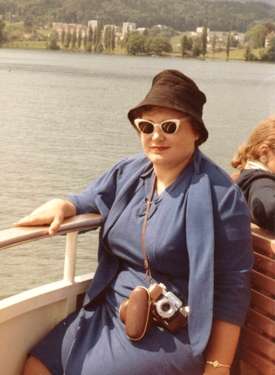
On Lake Lucerne, Switzerland, 1964
There were problems with this situation, though. In the first place, writing began to take me away from programming. Furthermore, what I wrote was either classified (secret) or proprietary, so that I couldn’t show it to anybody outside the company. And I began to feel that if I was going to write most of the time I would like to do it in a form that would appear publicly under my name. I did not have energy to do writing of my own in my off-hours, as many authors do; one full-time job was all I could manage without collapsing from fatigue. In the evenings I could do no more than read. Strangely, I didn’t even think much about space during those years, pleased though I was by the manned missions of the early sixties. I suppose underneath I avoided it because I wasn’t personally involved in the space effort. Many programmers worked on Gemini and Apollo, but I was neither energetic nor assertive enough to seek a new job and in any case, neither Florida nor Houston was a place we wanted to live.
By this time, Mother and I were sharing a home; for a while we’d had a very pleasant one with a swimming pool in the San Fernando Valley, but after my grandmother’s death we moved closer to Santa Monica because we preferred its climate and because commuting in rush hour traffic, which took longer and longer, tired me too much. Despite our new home’s high-priced locale and ocean view, I wasn’t happy there. I didn’t mind my lack of social life, since that of my office acquaintances appeared to revolve around sports and/or drinking, neither of which was my idea of fun; still my days seemed increasingly monotonous. My salary had enabled us to take wonderful vacations, including two to Europe—but these were somewhat shadowed by the fact that I was no better able to stay on my feet in Europe than anywhere else. I wanted freedom to travel at a more leisurely pace. Mother, for her part, was nearing seventy and found she didn’t want to be home alone all day while I worked, whereas I didn’t want to share our home with a housekeeper as had been necessary during the many years when my grandmother couldn’t be left alone.
Above all, I was homesick for Oregon; yet I had too much seniority to switch to the type of programming job then available in Portland. For the first time I seriously considered trying to write professionally. Mother’s income, we thought, had become more than ample for us to live on indefinitely (we didn’t foresee what inflation would do to it). Although once I’d have been unwilling to give up programming, my job didn’t involve much actual programming any more. Among the other difficulties I was being sent on business trips—for example, to talk with some Air Force officers at an underground installation in North Bay, Canada—and I found such assignments physically exhausting; yet I felt that to refuse them would mean the loss of my program design responsibilities. All in all, it seemed the time for another change was at hand.
*
I had worked as a programmer for almost exactly ten years when, in May of 1967, I came back to Oregon to stay. We bought another house in Portland—the first of several homes we’ve since had here—and I began to write novels. I didn’t look on writing as a career in the income-production sense, for I knew that very few authors earn a living from their books (and as it turned out, even the most successful of mine never brought in enough money for me to do that [except for a couple of years much later, when Enchantress from the Stars was republished.]). It’s important to make this plain, because I wouldn’t want aspiring writers to assume that one can quit a job thinking that publication of books like mine will provide support. I had no such illusions; I simply wanted to share some of my ideas. One reason I’d begun to feel I could publish in the young adult field was that Mother had recently begun to write for young people herself. Her second and best-known book, Twice Queen of France, was published that same spring (under her maiden name, Mildred Allen Butler). I thought that if she could do it, then, maybe, so could I.
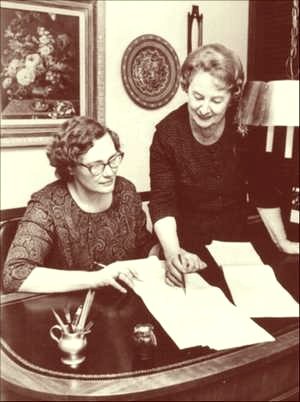
With my mother reading galleys, 1969
I wrote Journey Between Worlds first. I felt it would appeal to readers of romances for girls, and I wanted very much to make teenage girls aware of how important the colonization of space is to mankind’s future. I deliberately did not direct the book to science fiction fans. One such person wrote to me once, saying rather indignantly that I should have known no science fiction enthusiast could sympathize with a young woman who did not want to go to Mars—and of course I did know that! The idea was to reach girls who don’t ordinarily like science fiction. Unfortunately, in many places the book never did reach them because librarians put it on the “science fiction” shelf instead of the “romance” shelf. (I’d be happy if any librarians reading this would please go and move it right now.) Where it got into the hands of its intended audience, however, it was well liked. One of my happiest experiences as a writer was having a librarian tell me my book had convinced her that the space program really is worthwhile.
All this was quite a bit later, though. I submitted Journey Between Worlds to several publishers, all of which rejected it, and in the meantime I wrote Enchantress from the Stars. I didn’t feel Enchantress would ever be publishable—it wasn’t the sort of book that could appear as an adult novel (though I felt some adults would like it) yet it was over the heads of most readers below teenage and seemed far too long and complex to be called a children’s book, at least by the standards of the fifties and sixties. But the story took hold of me and I simply couldn’t leave it alone. I would forget all the rules, I decided, and amuse myself with something that didn’t fit any market while I waited for Journey Between Worlds to find a publisher; I couldn’t submit a new manuscript while that was unsettled in any case.
When Enchantress from the Stars was finished, though, I found I couldn’t bear not to have it read by anyone. I put Journey away and submitted Enchantress instead, after learning that at least a few publishers of junior books would consider manuscripts of its length. I sent it to Atheneum because they had published the longest children’s book I could find in the library, and also because the editor’s taste appeared compatible with mine. This proved to be a good guess; the book was accepted, after some revision, and went on to be a Junior Literary Guild selection and a Newbery Honor book. I was fortunate in having written it just at a time when a trend toward issuing more mature fiction as “young adult” was beginning. For of course, Enchantress was never intended for preadolescent children, and its Newbery Honor status was therefore somewhat misleading.
I have never written a novel for children—unless one considers teenagers “children,” which personally I don’t—and it bothers me somewhat to be known as a writer of children’s books. This doesn’t mean I don’t admire the gift of people who are able to work in that field; I’d be much better off professionally if I possessed it. But I, after all, didn’t identify with children even while I was a child myself, and have never understood them or their activities well enough to write about them. The characters in my novels are all in late adolescence or older.
The reason I mind being classed with children’s authors is that it tends to prevent my books from being found by the majority of readers most apt to like them. Teenagers do not consider themselves children, after all. Comparatively few of them visit the children’s rooms of libraries. The larger libraries shelve extra copies of my novels in their young adult or adult collections; that’s where teenagers are most likely to come across them. There are, to be sure, a few teen library users who know not all books in the children’s room are beneath them, and a few advanced readers below teenage for whom my books aren’t too mature. By and large, however, the “junior” label limits my audience, especially by keeping my books out of high school libraries, where I feel they’d reach more young people.
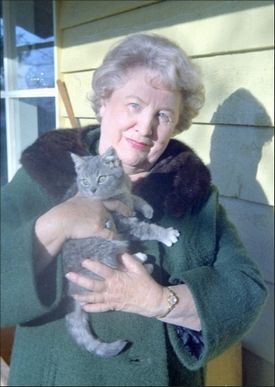
Mother, Mildred Butler Engdahl, 1968
This labeling of books by age group does a great deal of damage, I think, except in the case of those meant for preadolescent readers. The reason for it is solely commercial; it arises from the structure of the publishing business. The “children’s book” departments of publishers issue young adult novels because of the way books are marketed, not because there’s any good reason for fiction directed toward older teens to be branded as different from adult fiction. This is not to say that editors of children’s books, such as my own editor, Jean Karl, have not done a fine job with novels appropriate for high school age or that they shouldn’t be the ones to edit them—but they should be allowed, I feel, to do so without having such novels categorized as being on the “juvenile” side of a firm dividing line in literature. Even Library of Congress catalog numbering marks this division! Worse yet, because children’s libraries are patronized mainly by children, books for younger readers usually sell better than those that demand more maturity; and consequently publishers’ sales departments often list a novel as being for a lower age group than the author had in mind. This can backfire. Some of my novels were criticized by reviewers for being “too difficult for ages 10–14,” a judgment with which I wholeheartedly agreed.
With Enchantress from the Stars this problem was not as serious as with my later novels, since it could indeed be enjoyed by many readers of junior-high age. But Enchantress was given by teachers even to fifth and sixth graders; I was often asked to talk to those grades, and got letters from children who’d evidently read the book as a school assignment without having the slightest notion of what it was all about. I found this very frustrating. To me, a story’s plot incidents are not what matter; they were what I always found hardest to think of, and such action scenes as I managed to put in (usually long after the first draft of the rest) were a real struggle to write. The ideas in the story, plus the thoughts and feelings of the characters, were what inspired me, and in most cases these could be absorbed only by introspective older teens.
Adult readers, on the other hand—having less of a Space Age outlook than teenagers—didn’t all grasp what Enchantress was about either. To my dismay, some of them didn’t realize it dealt literally with relationships between peoples of different worlds. They assumed it was an allegory about our own world not merely in its portrayal of human feelings, but in a specific political sense; they thought that in saying an advanced interstellar civilization shouldn’t try to help less advanced ones, I was saying Americans shouldn’t give technological aid to undeveloped nations. I never meant that at all; people of different nations on this planet are all members of the same human race, the same species. Whether highly evolved species can help those younger than themselves is another issue entirely. Enchantress from the Stars was intended to counter the “Gods from Outer Space” concept, the growing idea, especially prevalent among young people, that UFOs may come here and solve all Earth’s problems for us. I simply don’t believe that’s how advanced interstellar civilizations act; I feel, as my novels explain, that it would be harmful to young species and that they know that. As I recall, I got tired of seeing Captain Kirk violate his Federation’s nominal noninterference policy in Star Trek, and that was what prompted me to create a Federation that lived up to its own code.
It’s tempting, of course, to hope that one will be contacted by people from the stars, especially if one doesn’t quite fit into society on this planet—and I suspect that dream is more common among the young than adults suppose. In my own late teens I indulged in it at times, very secretly, because there was no Star Trek or Close Encounters then and no one I knew was interested in space and I thought the wish for contact must be unique to my special form of imagination. A few years ago I heard a rock singer express the same wish in lyrics about a girl in a bar who longed to be taken aboard the “silvery ship” she was sure must be overhead. Evidently it is a universal longing. But I don’t think we should let it shape our view of the universe, because it’s a lot more constructive to assume we of Earth are going to have to solve our own world’s problems.
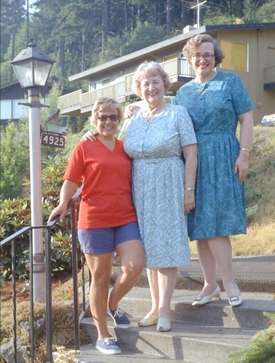
With mother and cousin Beverly Griffitts, 1971
Do I really believe interstellar civilizations exist? I’ve often been asked that, and the answer is that I do, though I don’t believe we are going to have any proof of it before we build starships of our own to explore with. But of course I don’t think inhabitants of other solar systems are as much like our species as they are shown to be in my fiction. Actually I rarely describe what they look like—partly because I’m not good at physical descriptions, but partly, too, because I want to leave readers free to imagine the characters as being like themselves. (In Enchantress from the Stars, for instance, I hoped black readers would picture Elana as black, and I’ve often wondered if any of them did.) This, I think, is just as accurate as making up weird descriptions for them would be; we haven’t the faintest idea what alien races look like, so why not portray them in a way that makes them easy to identify with? To me it’s the same form of literary license as writing the dialogue in English when we know that alien beings don’t speak English: it’s necessary for the sake of the audience. Few science fiction fans agree with me about this, but many people who don’t like other science fiction say they like mine, and I feel this is one reason why.
Alien cultures aren’t as much like ours as those in my books, either. And in fact, all the cultures in Enchantress from the Stars were purposely portrayed in an unrealistic, stylized way. This was something else a lot of adult readers didn’t understand. They saw that part of the book was told in fairy-tale style, and though they knew medieval cultures were not just like those in fairy tales, they recognized this as a literary device—which, if they were folklore enthusiasts, they enjoyed. Surprisingly, a lot of the same people said the culture of the invaders in the book was “stereotyped!” Indeed it was, deliberately so; real interstellar invaders would no more behave like comic-book villains with ray guns than real medieval heroes went around looking for dragons to slay. (This might have been clearer if my original Foreword had been printed intact, but that, like a number of other passages in Enchantress and a good deal of the punctuation, was altered by Atheneum without my knowledge, and it wasn’t possible to fix everything after the book was in galleys—something I’ve always regretted. Though I’m glad to revise my work repeatedly, I do not believe any author’s wording should be changed without his or her approval.)
Even the very advanced culture in Enchantress from the Stars, the Federation, was not shown realistically. How could it have been? I don’t know what the day-to-day life of people belonging to interstellar civilizations is like, but I’m fairly sure it’s not like Elana’s—in particular, a society composed of people possessing spectacular psychic powers would have to be very different and, from our standpoint, incomprehensible. Yet I believe that species more advanced than our own do possess such powers, and perhaps could awaken them in exceptional individuals of younger worlds. That, in fact, was the portion of the story I started with, the part conceived in 1957. Though its premise is classed with “magic” by today’s science, the book wasn’t meant to be fantasy in the sense that tales of magical worlds are fantasy. Rather, it was based on mythology (which is something quite different from fantasy)—not just traditional mythology, but that of our own age. At the time I wrote it, I didn’t fully appreciate the extent to which interstellar travelers with telepathic and psychokinetic powers are a contemporary myth; I was inclined to believe in their literal existence. Now I recognize that our current conceptions of advanced civilizations are much further from reality than fairy tales are from history. Nevertheless, I think the underlying ideas of the book, and of my subsequent ones, are valid.
When I finished writing Enchantress from the Stars (and had revised Journey Between Worlds, by then also accepted by Atheneum) I went ahead with The Far Side of Evil. It fit naturally into the same Federation setting as Enchantress, though my original story about the Critical Stage, which involved only Randil’s role, was set on Earth. I’ve sometimes been asked why the book’s conclusion didn’t reveal the key to the Critical Stage for which the Federation was searching: the reason why some worlds conquer space while others fail to, and blow themselves up in a nuclear war. My reply has always been that if I knew the key, I’d tell the President of the United States instead of putting it in a novel! For some reason this seems to surprise people; they don’t realize that I believe the Critical Stage is real. More disturbingly, some, again, thought the book was about politics instead of about space; they assumed I used a space story as a vehicle for political statements when in fact, it was the other way around: I used political melodrama as a vehicle for ideas about the importance of space exploration. I would like to think that readers of the book have found these ideas convincing, because they become more and more relevant to our world’s situation with each passing year. It frightens me when I hear people say we should solve the problems on Earth before we devote money and effort to leaving it. I do not believe they can be solved as long as our species is confined to a single planet. The natural course of evolution is for all successful species to expand to new ecological niches, and space is the one awaiting us. Attempts to postpone that destiny can lead only to disaster, for us and for all other life here on our home world.
*
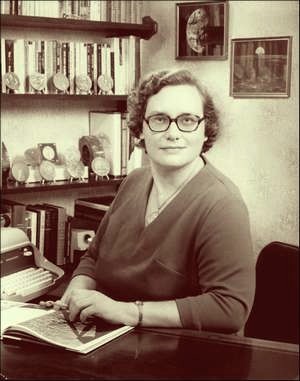
At my desk, 1972
My last remaining story draft was the one that became the foundation for This Star Shall Abide, which eventually turned into a trilogy. My previous novels had been written mainly from young women’s viewpoints, and had been praised for that reason by people who’d noticed the lack of space stories for girls. (Though there are quite a few of these now, Enchantress from the Stars was the first science fiction novel with a female protagonist to be issued as young adult. [This classification is determined not by the age of the heroine, but by which department of its publisher has edited the book.]) But I wanted to try something different, and in any case, the society in which the new novel was to be set was not one in which an adolescent girl would act as the plot required. It was a society that had regressed from its former state; the very sexism of its people was typical of their backward attitudes about a lot of other things—a point that somehow escaped feminists who later criticized the book and its sequel for portraying a sexist culture. So my main character was necessarily a boy, and he became very real to me, which was not surprising since Noren, more than any of my other characters, had a personality like mine. He viewed life as I had always viewed it: as a loner and a heretic. In my own case this had never been a very dramatic stance, but our society is not as bad as Noren’s, and I had not been forced to choose, as he was, between unjustifiable conformity and persecution. I can’t be sure that I would have acted as Noren did if I’d been born into his world, but I know I would have wanted to.
At the time This Star Shall Abide was written, the issue of youthful heresy was a major one in America, so I believed teenage readers would sympathize with him. Young people seemed a great deal more serious-minded than they had been during my own youth. To be sure, I felt that many of the causes to which they were devoting themselves were misguided, and that their methods of protest were often neither justified nor effective—I would not have felt at home in the counterculture of the sixties. Still, the young had begun to care about the world, and that in itself was progress. It’s better to care and make mistakes than not to care; both The Far Side of Evil and This Star Shall Abide dealt with that theme. In both there was real evil to fight, and in both, a young man’s sincere effort to oppose it turned out to be based on false premises: the point being that it’s right to defy authority for the sake of one’s conscience, yet necessary to take responsibility if one’s view of the situation proves inaccurate. But in Noren’s case deeper issues were involved. The original theme of the story concerned heresy not in the political but in the religious sense, and this facet of it became more and more central to me as the books developed.
I had never been an overtly religious person; my parents were not churchgoers, and though I’d taught Sunday School for a while during my high school years, I’d given it up because it made me feel hypocritical. I didn’t believe the teachings of any church literally, and at that time I knew of no other way to view them. That myth is true—that the underlying idea is more significant than the words and imagery through which it’s expressed—was something I came to understand slowly over a long period of years. I didn’t connect it specifically with religion at first. Even when I based Enchantress from the Stars on that theme, I wasn’t conscious of the fact that I was saying something about religious symbolism. Then, later, when I read Enchantress over after publication, it dawned on me that I had unknowingly written a strong defense of religious views I’d long rejected. To this day I don’t know if anybody else interpreted the book that way.
At that time, I had been ill for some months and was very depressed. Though my condition was not medically serious, I was not only too lacking in physical energy to do even what little had previously been possible for me, but had lost all desire and enthusiasm for such things as travel. I could write—and often did write ten hours a day—but leaving the house for more than brief errands brought on nervous exhaustion. Intellectually I was thrilled by the publication of my books, but emotionally I could feel no joy in that or anything else; my optimistic view of the universe did not extend to my private life. In desperation, I began to attend church, looking for some anchor in the dark sea that was engulfing me. For the first time I found the ritual meaningful—not because my beliefs had changed, but because I now recognized it as an expression of what I’d believed all along.
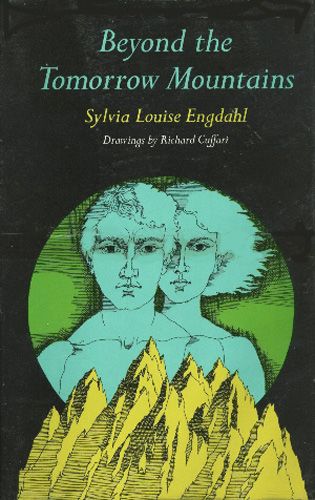
Cover of the 1973 Atheneum edition with art by Richard Cuffari
This was the period from which This Star Shall Abide and its sequel Beyond the Tomorrow Mountains emerged. Originally, I tried to tell the story in just one volume, but its structure was all wrong. When my editor didn’t find it convincing, I soon realized why: a lot of important things were still in my mind instead of on paper. So I expanded it to two and received a contract for both before the second was even partially written. Revising the first volume was merely a matter of removing an anticlimactic chapter from the end and adding a lot more detail in the portrayal of the planet’s society; that completed the novel as I’d first conceived it, the part I already had a plot for. But it didn’t finish Noren’s story, not even the love story to which readers would naturally want a conclusion, and my editor felt that it didn’t make the reasons for the inescapably bad situation on the planet clear enough. I agreed; moreover, by this time some of Noren’s later conflicts had become more crucial to me than his initial rebellion.
Presenting these conflicts in a way meaningful to young readers—or for that matter, to any readers at all—proved tremendously difficult. I didn’t yet have a plot, at least not in the sense of the action. I knew how Noren’s outlook would change but I hadn’t any idea what events would bring this about; thinking of them was a year-long struggle. Furthermore, Beyond the Tomorrow Mountains dealt more explicitly with religion than was customary in the young adult field. The old taboos concerning sex and politics had fallen, but judging from the books I saw, I feared religion might still be off-limits, if not to my publisher, then perhaps to reviewers and book-buyers. I thought I might offend some readers by suggesting that a religion unlike any on this planet could be valid to its adherents, and went out of my way in an Author’s Note to make plain that the colonists in the story were not descendants of Earth people. To my surprise, I later encountered adults who did not realize that the novel was really about religion! It didn’t mention God by name, so they apparently went on thinking of the faith depicted in the way Noren did initially, as no more than a feat of social engineering. But in my eyes, his ultimate commitment to a priest’s role was genuine.
This Star Shall Abide was well received, and won a Christopher Award for “affirmation of the highest values of the human spirit.” Despite good reviews Beyond the Tomorrow Mountains was less successful; the majority of those who evaluated it by young-adult criteria considered it too heavy and slow-moving, and my British publisher refused to accept it. (They had not liked the religious aspect of even the first volume and had insisted on changing its title to remove any suggestion of religious content—not because of a taboo, but because they felt, probably with justification, that religion doesn’t appeal to average science fiction fans.) Then too, some reviewers objected to the plot climax, calling it deus ex machina as if I’d been unable to think of any better way to save Noren than to drag in an improbable coincidence. There was much irony in this, since though I do indeed have trouble thinking up plot incidents, in this case the unforeseeable nature of Noren’s rescue was entirely deliberate. That was the point—sometimes one must have faith in an improbable outcome. That was what awakened Noren’s faith in the still more improbable salvation of his endangered people. But the book was not an action-adventure story, and those looking for excitement didn’t like its departures from action-adventure story rules.
Beyond the Tomorrow Mountains was primarily a psychological story. The younger readers had no comprehension of Noren’s emotions, especially during his period of what one reviewer aptly called “existential anxiety”—still I remained firm in my conviction that older adolescents would identify with them. I got confirmation that some did when one day a teenage girl approached me in a library and remarked appreciatively, “Noren really tripped out, didn’t he?” So much for the prevalent theory that action-adventure is what science fiction for young people has to focus on.
After publication of the second volume, some people felt the story still wasn’t complete; they told me I should write another sequel in which Noren succeeded in saving his people. I resisted this idea, since only in action-adventure fiction is it credible for a hero to single-handedly save the world. The book was about faith in the face of impossible odds, and that theme would be overridden if I altered the odds to the extent of saying that even during Noren’s lifetime, they hadn’t been so impossible after all. Besides, I’d done such a thorough job of making them impossible that I couldn’t think of a way out myself—and knew that even if I could, that would weaken the justification for the planet’s social system, which was an evil defensible only on the basis of its offering the sole means of temporary survival.
Years later, however, something happened that changed my mind. I got interested in the new field of genetic engineering, and learned to my dismay that the system on Noren’s world really wasn’t the sole means of survival! I’d honestly believed it was, since I’d been ignorant of genetics, but I was ignorant no longer and had just published a nonfiction book on the subject; what if people thought I’d known all along? I couldn’t let them assume I had let Noren endorse a morally objectionable system on false grounds. And so I wrote The Doors of the Universe, and once I got into it, I could scarcely believe that I hadn’t envisioned Noren’s story as a trilogy in the first place.
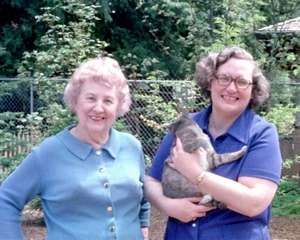
With my mother and out cat Pussywillow, 1975
It was truly uncanny the way things fit together. Details that just happened to have been mentioned in the earlier volumes looked like “plants” for essential premises of the new book. Moreover, in the new volume I had a chance to emphasize the theme, implicit in the earlier ones, of the tragedy that can result if a civilization turns its back on a promising technology—something I feel very strongly about. And I brought in connections with the themes of my books about the Federation. All this came easily (though as usual, I had trouble thinking of events through which Noren actually could reach his goal and was stalled in the middle for over a year without any more notion of the solution than he had). So now, the conclusion of Beyond the Tomorrow Mountains does indeed seem incomplete to me, which for a middle volume of a trilogy is entirely proper. I hope that young people who grew up during the interval between publication of the second and third volumes have found that the third exists, though in most cases this is unlikely [or was, until the trilogy later became available in ebook form]; the story really is much better when read as a whole.
The Doors of the Universe got excellent reviews but was not widely distributed because by then the library market was diminishing, and, dealing as it did with Noren as an adult, it was much too heavy for average readers of young people’s fiction. Genetic engineering being a timely topic, I hoped it would go into paperback even if the whole trilogy did not, but Atheneum did not succeed in selling the reprint rights.
My greatest disappointment as a writer has been the lack of mass-market paperback editions of my novels. This is a matter not so much of money (though by now I surely need the money) but of the fact that many teenagers prefer paperbacks. Science fiction readers in particular don’t all have access to, or opportunity to use, public libraries; I’ve talked to some on electronic bulletin boards who’d like to read my books, yet cannot get copies. I would have a far larger audience, particularly for the trilogy—which unlike some of my books, did not appear even in children’s paperback form—if it were available on racks where science fiction is sold. Yet according to Atheneum, my novels were repeatedly offered to reprint houses and turned down. It was not because they were originally issued as young adult novels—I think I’m the only author of teenage science fiction whose books had success in hardcover and yet were not picked up for mass-market reprint. I was told it was because they hadn’t enough action, that they were considered “too difficult” even for average adults. Possibly so; but I think a larger factor was the restrictive categorization of the paperback field.
Under the current marketing system, a mass-market paperback line must be labeled either “general audience” or “science fiction”—there is no common ground between the two. Books about other worlds are not issued in “general audience” lines. Yet my novels don’t appeal to typical SF fans; I don’t slant them that way. A science fiction writer once told me that in order to do so I would have to direct them to people who have read at least 500 other science fiction novels previously! Such readers are looking for far-out material that I wouldn’t be able to imagine even if I wanted to, and I don’t want to. I write for those, adults as well as teens, who care about the real world and its relation to the rest of the universe.
*
Once Beyond the Tomorrow Mountains had gone to the typesetter, I had no other story idea. But I did have something else in mind. I wanted to try nonfiction. Especially, I wanted to write about what people have thought in the past about other worlds: not science fiction authors, but scientists, philosophers, and average citizens. Radio astronomers were then implying, and in some cases saying, that their belief in the existence of other inhabited solar systems was something new; but I was aware that this view of history was a limited one. The philosopher Giordano Bruno was burned at the stake in the year 1600 for holding to such ideas. And if a conviction that we’re not alone in the universe goes back that far—if it’s not an invention of science fiction at all—then surely that is an important fact. Perhaps it reveals something of what people instinctively sense to be true.
Ordinary history books don’t tell the facts about things like views of extrasolar worlds; only a few specialized scholars know them. None of these scholars had written about the subject in detail—the information was to be found only in actual writings of the past. I had never done scholarly research before, but I soon became fascinated with it. I ended up spending an entire year searching the writings of well-sknown people who lived in the seventeenth, eighteenth and nineteenth centuries, plus a lot of magazines printed in those centuries. Portland’s libraries didn’t have all I wanted to see, and I thought with regret of the lost years in Southern California, where I’d lived near many great libraries without ever using them for research purposes. I sent for a few crucial books via interlibrary loan, obtaining them from cities in the East as well as California, often finding them so frail from disuse that they fell apart in my hands. And what I learned was that the educated people of those centuries almost all believed that other inhabited solar systems exist. Benjamin Franklin and Thomas Jefferson did. The majority of clergymen did. In the nineteenth century, the few writers who argued against the idea were considered dissenters.
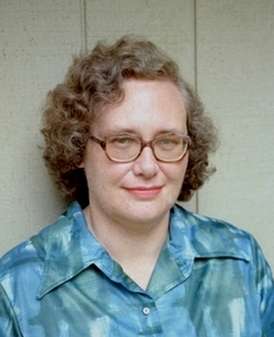
Sylvia Engdahl at age forty-two
These facts are still not generally known. My collection of Xeroxed sources on the subject provided material not merely for a young people’s book, but for a long scholarly one—which I still intend to write when I have opportunity. [As of 2016, this is no longer true, as a number of scholarly books on the subject appeared some time ago; but in 2012 I did publish an updated version of The Planet-Girded Suns as adut nonfiction.] I have found that both my writing style and my approach to ideas are far better suited to scholarly writing than to anything else, and that that’s the type of work I normally find most fulfilling. I’ve since gathered material for a number of other scholarly books on different subjects, and have enough more ideas to last for the rest of my life. Scholarly writing, however, is not usually publishable unless it’s the work of a college professor or other recognized authority. It remains to be seen whether any of the projects I’m working on will ever appear in print.
During 1973, I wrote The Planet-Girded Suns: Man’s View of Other Solar Systems, which was publishable when a scholarly book would not have been. I did my best to make it understandable to young readers; it was revised many times at the request of Atheneum, and was eventually accepted and well reviewed. However, it was actually neither one thing nor the other—not scholarly, though it presented material that popular-level adult books don’t include, and yet much too difficult reading for average teens. It was interesting to some because the subject of other worlds is interesting, but on the whole I am unable to explain complicated ideas in a way that appeals to large audiences. I hoped, because adult books about extraterrestrial intelligence were then popular, that The Planet-Girded Suns would have a better chance than the novels at paperback publication, but paperback houses showed no interest in it. Perhaps this was because, in the section about modern scientific beliefs, I didn’t endorse the existence of UFOs.
There followed a period of years during which I tried desperately to write yet could not produce any fiction. Several times I thought I had the basis for a new novel, but despite interesting themes and settings I proved unable to think of events. Unlike the situation of authors who experience “writer’s block,” this was not a matter of having trouble putting words on paper, or of producing things that weren’t good. I couldn’t write narrative at all because I had no incidents or images in mind to describe, but I wrote thousands of words, constantly, about abstract ideas, often in long letters to friends. At the time I felt I should write more novels because I’d assumed I would keep on doing so, and Atheneum was waiting for one; it seemed terrible not to take advantage of that opportunity. Apart from liking to publish I was beginning to need income; Mother’s no longer went so far because of inflation, yet I couldn’t work outside my home because her health was poor and she needed me. So for a long time I kept struggling. But I’ve since come to realize that the mystery is not why I could no longer write fiction, but why I’d ever been able to do it in the first place. Most people with analytical minds (the kind now called “left-brain dominant”) never can.
One of the friends I wrote long letters to was a young man named Rick Roberson, who lived in Tennessee. He’d first written to me when he was sixteen, and just the type of teen reader toward whom I’d directed my books—he grasped what was in them and identified with the characters more than anyone else I knew. Rick and I went on corresponding because we were both seriously interested in space and the future, and neither of us had other friends who were. Also, he had writing talent. The year he entered college and I had no book ready to publish, science fiction anthologies for young people were needed, and it occurred to me that between us we could produce one. I had little background even as a reader in the SF short-story field, but Rick did, and he knew what young people liked. We mailed stories we found back and forth to each other and enjoyed discussing them; then Rick wrote the introductions and I handled the business of obtaining permission to reprint them. This became the anthology Universe Ahead. Rick wrote a story for the book, and when we became desperate to fill a remaining “slot” I produced one myself, which I was able to write only because I based it on his ideas and which therefore appeared under both our names.
I found I liked editing. The next year Rick wrote another story and I asked some of my other friends, all published authors, to do so also for a new anthology, Anywhere, Anywhen, which contained only fiction that hadn’t been printed before. Again, I co-authored a story, this time with my mother. Sadly, Mother’s career in writing for young people had come to an abrupt end when book markets changed so that her special interest—history—was no longer an acceptable topic; it was felt that teenagers weren’t interested in history. (After four books for Funk & Wagnalls she had had a new one accepted by Harcourt Brace, only to have the new management there decide not to issue it despite their loss of the advance already paid. [In 2013 I produced an ebook edition of this book, The Disobedient Queen.]) Finding it hard to believe young people couldn’t see the relevance in history, I adapted one of Mother’s historical narratives into a time-travel story that we felt made that relevance plain. I don’t know if readers of Anywhere, Anywhen agreed or not. In any case the book was not successful, largely because it was usually passed to science fiction specialists for review. Naturally, such specialists didn’t like it; everything in it was “old hat” to them, since it had been deliberately designed to appeal to people in the children’s literature field who don’t care for typical science fiction anthologies. Hardly anyone, though, recognizes the wide gap in taste that exists between genre-oriented SF fans and other readers, or that efforts to bridge that gap are not welcomed by the specialists.
*
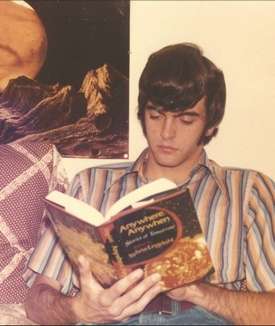
Rick Roberson with advance copy of
Anywhere, Anywhen, 1976
In the summer of 1976 Rick Roberson came to Portland and stayed with us while attending summer school at Portland State University. His college major was physics, and I felt that there would be interest in a children’s book about the exciting new discoveries being made in high-energy physics. I wouldn’t have ventured to write nonfiction on such a subject alone, since I knew nothing whatsoever about it; but together we produced The Subnuclear Zoo. Then the next year, Rick started to write a similar book about genetic engineering, a subject in which he was also knowledgeable—but as it turned out, he didn’t have time to finish it, so we co-authored that one also: Tool for Tomorrow. Atheneum wanted these books to be for younger readers than my previous ones, and I tried very hard to comply. Nevertheless, I wasn’t able to achieve a style appropriate for sixth graders. That being where the major market was, neither book did well, though they both got some good reviews.
I tried a picture book. While working as a science consultant for a textbook literature series, I discovered that there weren’t any picture books about space, and I felt that even very young children were aware of space from television and movies. So I wrote Our World is Earth. Ironically, that book was assumed by reviewers to be for older readers than I intended! (Some of them said it was too elementary to appeal to the first and second grades, which of course it was; I’d meant it to be read aloud to preschoolers.) I tried other nonfiction that I never submitted; though my major interest had come to be in the promise of orbiting colonies, which I now feel are the solution to Earth’s long-term problems, I was unable to express my thoughts about them in words concrete enough for children. This is an insurmountable problem for me—once I wrote a controlled-vocabulary piece about Skylab for a reading series, and was told that the editor had to rewrite it because despite my accurate vocabulary/sentence structure calculations, my approach was “too abstract” for the intended audience. This is the underlying difference between my view and other people’s, and it bars me not only from writing children’s nonfiction, but from the popular-level adult science field.
But working on The Subnuclear Zoo and Tool for Tomorrow had opened new doors for me. Though originally, I had assumed Rick would provide all the technical information, I found myself inwardly compelled to absorb it myself before I could express any ideas on paper. Furthermore, I found it wasn’t as obscure as I’d been expecting. One day, coming back from a summer school class to find me reading a technical article about physics in Scientific American, Rick said, “Oh, Sylvia, you can’t understand that!” And I reacted indignantly—I felt challenged, and became aware that there really was no subject I couldn’t comprehend if I made the effort. To be sure, I couldn’t understand the mathematical equations, not having nearly as much math background as Rick did; but contrary to what’s often asserted, math is not necessary to the understanding of concepts, indispensable though it is for practical or experimental work. My lack of college training in science did not limit the subjects I could deal with as a writer.
So while I was working on the genetic engineering book, I got very deeply involved in the source material. That was when I saw its application to Noren’s situation, and started The Doors of the Universe (an exception to my inability to think of stories because it was a continuation of the original story). But besides that, I wanted to learn more about the relation of genetics to human evolution. I visited Rick’s home in Tennessee to put the finishing touches on Tool for Tomorrow; he was then making plans to enter graduate school. I realized that soon he would have a master’s degree, while I had none. My mother and most of my friends had master’s degrees in one subject or another, though they knew far less about scholarly research than I. Also I felt that perhaps a master’s degree would enable me to publish adult nonfiction about other worlds without its getting classed with the sensational variety—I’d gotten tired of hearing “Oh, you mean like Chariots of the Gods?” when trying to tell people about my research for The Planet-Girded Suns.
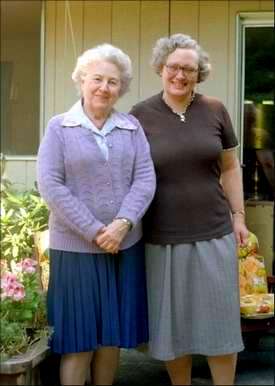
With my mother, 1981
In 1978 I had a contract with Atheneum for a book about future human evolution. I knew little about past evolution, but instead of learning from books alone I decided to try taking a class. I had never been fond of the Academic Establishment or in agreement with its accepted theories, but the appeal of a master’s degree was at that time motivating me; I found out that it would be possible for me to get one in anthropology at Portland State University. The professor for the evolution class in which I enrolled turned out to be excellent, and, by coincidence, interested both in genetics and in philosophy of science—both fields in which I’d developed background. He encouraged me to apply for admission to the graduate program, and I was accepted. For the next two years I attended part-time and met all the M.A. requirements, receiving almost straight A’s because I found researching and writing term papers easy. The book for young people on future evolution, however, was never written. My views on that subject proved to be at odds with those of anthropologists, and I could scarcely express them in print while a candidate for a degree; moreover, to do so wouldn’t have been fair to Atheneum. Nonfiction published for young people (as opposed to fiction) is supposed to reflect the current views of authorities, not the heretical ones of its author. I transferred the contract to The Doors of the Universe and abandoned children’s nonfiction with little regret.
I never did get the master’s degree. I had to stop work on my thesis temporarily for personal reasons, and then wasn’t able to go back; it had become too expensive to have someone stay with Mother during my hours on campus. I wasn’t too disappointed, for by then, I realized that the degree would not really enable me to publish nonfiction for adults. The scholarly book field was in a depressed state and it was unlikely that I could get the thesis accepted by a university press, as I’d first hoped. Without that prospect, I didn’t want to write it under Academic Establishment guidance—term papers are one thing, but an original book-length manuscript containing controversial ideas is something else! I would rather use my material for something wholly my own, far longer than a master’s thesis is allowed to be. I do plan to finish that book whether or not it proves publishable; it’s about the significance of space colonization to human evolution.
*
Going to graduate school was largely a matter of pride with me, and though I gained confidence from it, with hindsight it appears to have been the most expensive mistake I ever made. Those two years were when personal computers first came on the market. I avoided looking at the ads because I longed to program again and yet saw no way I could ever afford such an expensive luxury; but if I had put the money I spent on graduate courses into a computer, I undoubtedly could have sold software profitably. Although my programming experience was by then too outdated to be applicable to large business computers, I had just the kind of systems software knowledge that was needed for programming early microcomputers in assembly language. But I didn’t realize people were selling programs by mail from their homes. I assumed one would have to work in an office, which I wasn’t free to do.
When in 1981 my electric typewriter gave out, and I’d developed a vision problem that made it difficult for me to use a typewriter anyway, I did get a computer for word processing. I couldn’t afford to buy software but I enjoyed writing my own. By that time I’d become aware of what was going on and tried to market what I wrote, but it was already too late. Advertising rates were by then geared to the price of products for business customers rather than home users. Though my software was bugfree and my few customers were pleased with it, there wasn’t any way to publicize it—and furthermore, my computer soon became too obsolete to use for commercial software development. It was a cassette-based TRS-80, which like the old Q7 did its job well, but was scorned by people interested in having the latest and most efficient equipment. Personally, I liked it, and did all sorts of things with it that are supposedly impractical with cassette tape storage.

Hesper and Sunny with my TRS-80 computer, 1981
(Keyboard covered to keep kittens off.)
The attempt to market my software, like so many other things I’ve done, had serendipitous results. That was what got me into telecommunications and computer conferencing, a fascinating new field in which I’m now active. I hope that ultimately it, or the contacts I make through it, will offer me ways to earn money at home, for I no longer foresee any writing income; my talents don’t fit present markets. I will write in the future as I did at the first, for the satisfaction it brings to me and to prospective readers. But even if I were to get an idea for a novel like my others, it’s unlikely that it would be published. Libraries are low on funds these days and books for advanced readers, long and costly to print yet without appeal for typical younger teens, are no longer salable. The seventies were really the only time during which they were; I was very lucky to go through my story-creation period in the right decade.
Mother is over ninety now. Though her mind is sharp and she does a lot of reading, she’s very weak physically due to medical problems; I can’t leave her alone at any time. During my grandmother’s lifetime we could get someone to live with us for little more than room and board, but that’s no longer possible, so except for taking her to the doctor I’m virtually homebound. We live very quietly with two beloved cats, Hesper and Phoebus (called Sunny), who are the center of our household. Recently we sold the house we’d owned for thirteen years—far longer than either of us had lived in one place before—and moved into a mobile home west of Portland. It’s in a beautiful park surrounded by tall firs, with a view of tree-rimmed fields and a red barn from my bedroom window.
I don’t mind this lifestyle, except for its financial drawbacks—after all, I stayed home by choice before it became necessary. I have always been an observer of this planet more than a participant in its affairs. All writers are good observers; the difference between me and most others is that I tend to observe in terms of long-range things, like the evolution of space-faring species, rather than nearby specific ones.
It has been ten years since I’ve traveled anywhere and I see few people, yet I am not isolated. My computer is my link to the world, not only because I write with it, but because of computer conferencing. At present I am on the staff of Connected Education, an organization headed by Dr. Paul Levinson that offers graduate courses for credit from the New School for Social Research in New York City. Every night I connect my computer by phone to a central computer in New Jersey, where Connect Ed’s “electronic campus” is located. [This was in the pre-Internet era.} Though I haven’t met Dr. Levinson in person and I have never seen the New School itself, I’ve team-taught a class there, and will be teaching more courses as the program grows. Connect Ed has students and faculty all over the world—Japan, South America and England, among other places. These people are as easy to “talk” to as they would be if they lived in my own city. In my case, because writing’s easier for me than speaking, it’s far better than attending face-to-face conferences. Long ago I assumed that because I couldn’t lecture I would never be able to teach in college, yet now technology has found a way to break down barriers not only of distance, but of individual differences in skills. In computer conferencing, people’s minds and personalities are all that matter. Irrelevant things like foreign accents or physical handicaps aren’t even visible; we all meet on equal ground. This is truly the medium of the future, I believe.
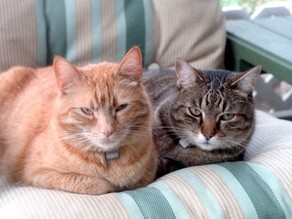
Sunny and Hesper, 1988
Of course computer conferencing isn’t just for people who can’t meet otherwise; most Connect Ed students live ordinary lives and choose online courses for scheduling convenience. Because it’s an expensive medium at present, the majority of them are business people, though other adults such as teachers are certainly welcome. But I foresee a day when young people will be involved, as they now are with free electronic conferencing on local BBS systems. National recreational computer conferencing has great appeal for teens. In 1985 I was a Helper and volunteer writer for the Participate® conferencing system on The Source, which I learned about while participating in Paul Levinson’s public “electure” conference about Space Humanization there. We had enthusiastic teen users as well as adults, though there too, the expense barred all but those from affluent families. I’m hoping for a time when all young people will have access to such systems. There may even be a time when young readers can exchange ideas with their favorite authors via a computer conference.
In any case, computer conferencing is an exciting field to pioneer in. It’s something I’ll be doing for many years to come. I have a brand new computer now (this article is the first thing I’ve written with it) and many hundreds of thousands of words will scroll across its screen. Some won’t ever be printed on paper; I send words to readers nowadays merely by pressing a few keys. But there’s still an important place for books—unlike some of my fellow electronic text enthusiasts, I don’t believe books will ever become obsolete. I hope to write more of them someday.
*
Postscript (Summer of 2001)
What a difference a few more years made in computer technology! The desktop PC that was new in 1987 when I wrote my original essay, primitive by today’s standards, is long gone; I’ve just acquired my third successive improved model. I said then that online communication was expensive (which it was, in the days when we paid by the minute for connections to host conferencing systems) but that I hoped someday all teenagers would have access to it. Now they can contact people all over the world, from schools and libraries if they lack computers at home, via the Internet—a development I then hadn’t imagined.
There might even be a time, I said, when readers could exchange ideas with authors online; but I pictured that as a quite futuristic possibility. Only ten years later I opened my own Web site and began corresponding by e-mail with fans of my books in many regions of the United States, as well in other nations. As a direct result of this, I’ve at last been able to get most of my novels back into print.
But before that, there were other major changes in my life.
In the fall of 1987, shortly after my autobiographical essay went to press, my mother died. This loss was crushing for a while, although it was scarcely unexpected, since she was ninety years old and had serious medical problems. We had lived together all my life, except for a few years during the 1950s, and for most of that time she’d been more like a sister to me than a parent. I will never stop missing her company.
And there was another problem. I had chosen to share a home with my mother not only because of our closeness, but because she wanted a full-time companion and, ultimately, caregiver. Had I not been present she would have hired someone; thus I didn’t object to the arrangement whereby her modest income—inherited from my grandmother, for whom she had cared in turn—supported both of us. After all, I had never craved a high-powered career or upscale lifestyle. Our assumption was that after she was gone I could live comfortably on my own inheritance. We didn’t anticipate the extent to which it would be depleted by inflation.
It’s just as well that we didn’t, I suppose, because there was nothing different I could have done. After I stopped publishing I tried—and have since tried—to earn money at home; but the amounts have been small, and though I would have been free to take a job in the years immediately following Mother’s death, there was no position for which I was qualified. My programming knowledge was by that time far too outdated to have value in the marketplace, and because of my lifelong typing-speed limitation I could not do office work. Moreover, I didn’t have the physical stamina for a regular job; I’d always found commuting exhausting, and by this time there were often days when I hadn’t the energy to go out—though I am always able to work at home at my desk.
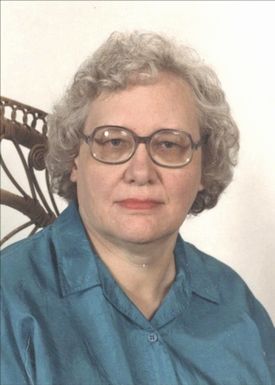
Publicity photo, 1989
So the immediate question was where I was going to spend the rest of my life. I owned the mobile home we’d been living in, but it was sited in a park where there was rent to pay; I knew that I must own my land, too, in order to make ends meet in the future. I couldn’t afford property in the Portland area—and found that I didn’t want to stay there in any case. For years I’d been virtually homebound, and had few local contacts; now I discovered that the distances I had to drive through traffic in order to get anywhere, even the main public library, were too great to make the effort seem worthwhile. Portland had changed. It wasn’t the same place I’d so eagerly moved to, twenty years before. I felt I must make a new beginning.
At this point came another of the astonishing coincidences that have shaped my life, and which, along with several other instances of fortunate timing, have made me wonder whether such synchronicities may be more than mere chance. Strangely, a trip from Portland to Eugene triggered both of them. Since the spring day in 1957 when I went to Eugene and made a sudden decision resulting in my coincidental entry into the computer programming field, I had been there only three times. But in April of 1988, I decided to drive down to Eugene again. I wasn’t really sure it was where I wanted to live, although I had loved it during my brief stay in the early 1950s—and when I arrived, mobile home lots proved scarce and costly. I was about to give up the search. Then, through a casual inquiry, I discovered a subdivision of such lots involved in a bank foreclosure, the prices of which had been drastically reduced the day before. Realizing I must act fast, I bought one of them. By the next weekend they were all gone; if I had not picked that particular time to visit, I would never have found land within my means.
So all my early contacts with Eugene proved fateful—not to mention the fact that I’ve settled permanently here, and thus may, in due course, come to the end of my life in the hospital less than a block from where I lived that magical year when I was seventeen. How surprised I’d have been then to know that Eugene is where I’ll grow old! Going through boxes of papers not long ago, I came across a houseplan I drew in a high school homemaking class. We were required to design our dream homes. I labeled mine “Engdahl Home, Eugene, Oregon” although at that time I had never been to Oregon and had no reason to expect that I’d ever have occasion to see this particular city. I just picked it from a map. Prescience? Who can say?
Having my mobile home moved from Portland to Eugene proved to be quite an adventure. Actually it was easier (for me, anyway) than a regular move, since all the furniture moved with the house; I didn’t have to pack anything that wasn’t fragile. The double-wide home was split in two; though I moved the books from shelves to the floor, I have such a lot of them that their weight caused one half’s hitch to break, and it got stuck overnight on the highway. I was already in Eugene by that time, wondering why only the bedroom side of my house had arrived. Eventually it was all put together, the only other snag being the requirement of Eugene’s building inspectors that my sloping carport be built with strong enough timbers to support four feet of snow, although it rarely snows more than a few inches here and some years get none at all. The expense of this proved so great that I’d have been better off building a garage, which, if I’d realized I would be keeping my 1978 Chevrolet—now approaching “classic” status—for the rest of my life, I would have done. There were a few other lot-development choices I now regret, but on the whole, the move was a big success.
My cats, Hesper and Sunny, moved with me, of course. Hesper lived to be nearly nineteen, which for a cat is very old indeed. Sunny died much earlier, and I got Marigold, an orange tabby who now rules the house. Cats have always been important to me; I could never be happy without feline companionship.
I love this place, although the site isn’t as pleasant as when I first came. Then, wild geese flew low overhead, and over the back fence I saw trees between here and the river; I often sat in my screen porch and watched the sunset. Now those trees are gone and they have built a rock quarry bordered by huge berms of dirt that block the western view, and fill the porch with dust every time the wind blows. They are planning to widen the highway in back, which I don’t welcome since it’s only a short distance from my bedroom and is bound to create more dust and noise. But the trees in my yard have grown tall, and I can still see forested hills from my living room windows.
Eugene is just the right size city for me. It has everything, including a major university, yet it takes me only ten minutes to get downtown from the outskirts where I live—even less time to reach the main shopping mall. It has retained the natural beauty of its setting. And I’m active in community organizations in which, in a large metropolitan area, I could never have become involved. I’ve been on the board of the Friends of the Eugene Public Library since a few months after I arrived, and as a volunteer, I desktop-publish the Library’s newsletter at home on my computer. I also produce a newsletter for the Alzheimer’s Association, and I’m on the advisory council of the local RSVP (Retired Senior Volunteer Program), for which I’ve done various computer tasks.
Nevertheless, I live quietly, and am home most of the time, usually with the computer on (my latest enthusiasm is for selling things I no longer need on eBay and Half.com). It’s the way of life that best suits me. I no longer drive to the nearby mountains or coast as I sometimes used to, partly because of my car’s aging condition and partly because of my own. I have no specific medical problems, just ongoing depletion of my already-low energy level and, in recent years, chronic muscle pain. I lack both the funds and the stamina for travel, and were I to be miraculously provided with one, I would still be held back by the absence of the other. It’s been nearly a decade since I even visited Portland.
Yet sitting at my computer, I come alive! I will never tire of the various pursuits it makes possible for me.
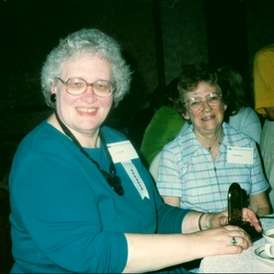
Accepting the Phoenix Award, 1990
In 1989, to my great surprise, I was informed that I would receive the 1990 Phoenix Award for Enchantress from the Stars. This award is given annually by the Children’s Literature Association, a national organization of scholars in the field, “from the perspective of time” to a book published twenty years prior to the award date. I received an expense-paid trip to San Diego to accept the award and speak at the organization’s 1990 conference. Also in 1989, rack-size trade paperback editions of Enchantress and The Far Side of Evil were issued, which stayed in print for a while; but their covers didn’t attract the right audience and they weren’t widely distributed where teens would find them. It seemed that although my novels were still valued by critics, they were destined to remain inaccessible outside of children’s rooms of public libraries.
In the late eighties and early nineties I was still doing the part-time online work for Connected Education that I described in my original essay; but the cost of that program—the same as on-campus tuition at New York’s New School for Social Research—put it out of the reach of all but the most affluent students, and enrollment was never large. I did teach an online graduate course titled “Science Fiction and Space Age Mythology” in 1989, 1994, and 1995, which I greatly enjoyed; I wish there had been enough students for it to run every year that it was offered. The course dealt with popular culture science fiction, not the literary kind, and was focused largely on films. . [Since 2003 all my “lectures” for the course have been online here at The New Mythology of the Space Age.] An idea of its content is given in my Phoenix Award acceptance speech, “The Mythic Role of Space Fiction,” a slightly revised version of which is now at my Web site. In my opinion this new mythology is an extremely significant reflection of our culture’s outlook on the universe. I have worked, off and on, on a nonfiction book on the subject, the scope of which keeps growing; but because it’s not suitable for publication in today’s commercial market, and I would not have the academic credentials to publish scholarly books even if there were a bigger demand for them, I have not given it high priority.
Connected Education was conducted via private text-based online conferencing systems rather than on the Internet, which in those days was just getting started. In 1996, when the public was becoming aware of the Web, I was asked to develop a site publicizing Connect Ed’s offerings, and was provided with access to the Net. This was all new to me. I had been online for more than a decade but had never seen a Web page; I didn’t even have Windows on my computer, and didn’t have memory enough to run it—they also paid for me to install more memory and get a faster modem. But when I started to learn HTML, I found it fascinating. This is a wonderful new career! I thought. It’s something I’m naturally fitted for!
Alas, it has not turned out that way. Web design is a highly competitive field in which a freelancer cannot find work without contacts or money for advertising. I haven’t been able to get much, though I did create, and continue to maintain, one site for another author. By now, of course, there are thousands of Web designers looking for freelance jobs and plenty of high school and college students with as much capability as I have—and besides, today’s software enables people to produce their own Web pages.
So as in the case of all my ventures, the financial return was not large. But the rewards of developing my personal Web site were another matter.
*
Early in 1997, Connect Ed’s program came to an end, and I was faced with having to pay for my own Internet account, an ongoing expense I could not justify unless it brought me income. I had some extra copies of my novels left, and since I saw that a few people had been searching for them through Usenet groups, it occurred to me that it might be possible to sell them. I didn’t think many Internet users would have heard of them; still, I placed a notice saying they were available, and also opened a Web site where they were offered. As their original prices were out of line with current ones, I thought it would be legitimate to charge what a new book of equivalent format would cost—even a few dollars more, in the case of those that were scarce and had never been issued in paperback.
The response was overwhelming. It seemed I was better known than I thought, although often viewed as a bygone author (comments appeared in a couple of places expressing surprise that I was not dead!) I sold all the hardcovers—of which I had only a few—within a week or so, and the paperbacks in about three months. I could have charged much more; I later found that used book dealers were getting well over $100 apiece for some of the hardcover titles. If only I had bought more while they were still in print! I hadn’t dreamed then, of course, that there might someday be a way to contact potential buyers.
My Internet presence was paying off, but more than that, I began to wonder if it might not lead to new hope of attracting reprint publishers. For much more gratifying than the sale of copies was the e-mail I received. I’d had no idea that my novels were so widely remembered.
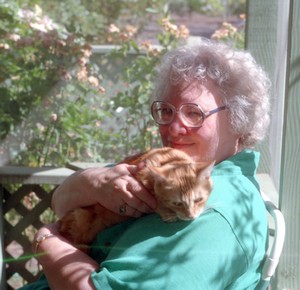
With my cat Marigold, 1992
Nothing in my experience, at any time in my life, has pleased (or astonished) me more than the discovery of how many adults had read my books during their childhood or teen years and felt that they had been influenced by them. Not only did people send e-mail, but in searching the Web for ways to publicize my site I came across comments made previously in public forums. In former years, I had received praise from reviewers and librarians, and had sometimes gotten letters from children assigned to write to authors in school, but only on rare occasions had I heard from readers who reacted personally to the novels. I was, and still am, deeply touched to know they've had lasting impact.
After I suggested at my site that Guest Book comments might help to get the books back in print, many were made. Then in 1998, Meisha Merlin—at that time a brand new press—stated at their own Web site that they would welcome e-mail about books people would like to see reprinted. I asked the people who had written to me to respond, and a lot of them did. Subsequently Meisha Merlin offered me a contract, and in 2000 my trilogy—This Star Shall Abide, Beyond the Tomorrow Mountains, and The Doors of the Universe—was published, with minor updating and a new Afterword, in an omnibus edition under the title Children of the Star. It was issued as adult science fiction. The Web has created a whole new way of reaching people who like books of a kind not interesting to large mass-market audiences.
All that I said in 1987 about publishing categories is still true, and furthermore, large publishers have become increasingly oriented toward commercial success. Meisha Merlin specializes in reprinting science fiction and fantasy with good reviews and an established following, but not enough mass appeal to be wanted by those publishers. It has issued the work of many authors whose books had gone out of print. Without the Web and its new outlets, such as online bookseller, publisher and author sites, the marketing of such novels would not be possible; small presses cannot get books into many local stores, and there would be no way to publicize them sufficiently for conventional distribution. The wide reach of the Web is now changing the rules of the game.
Unlike some traditional publishers, small presses don’t object to authors selling copies of their own books, and—since I get a bookseller’s share of the cover price—I have earned far more per copy from offering Children of the Star at my Web site than I earn in royalties. The book, which has stunning cover art by noted fantasy artist Tom Kidd, had a limited print-to-order hardcover edition for which both the publisher and I took advance orders, followed by a high-quality trade softcover edition that’s available through normal book trade channels. The only problem is that few people discover it unless they’re already familiar either with my books or with Meisha Merlin’s. Catch-22: science fiction media didn’t review the original editions because they were YA books, and now that it has been issued as adult, they won’t review it because it’s a reprint. There have been some enthusiastic reader reviews at Amazon.com, though (which unfortunately are seen only by people who search for me there). And I do what I can to publicize it myself via the Internet, something many authors are now doing; the days of expecting even a major publisher to handle all publicity are past. I hope that in time it will reach new readers, both older teens and adults besides those who’ve read it previously.
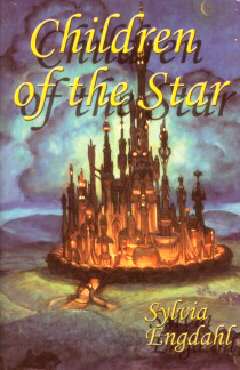
Cover of the 2000 Meisha Merlin edition with art by Tom Kidd
An even more exciting development is the publication of a new hardcover edition of Enchantress from the Stars this spring by Walker and Company, with an introduction by Lois Lowry and a striking new jacket plus interior vignettes by artists Leo and Diane Dillon, who have won top awards in both the children’s and the science fiction fields. Walker, which has a large and successful children’s book department, contacted me last year about obtaining the rights to it for their Newbery Honor Roll series. Whether this resulted from the revival of interest in my work brought about by my Web presence, I don’t know. But I’m delighted that Enchantress is available to a new generation, and furthermore, I am glad it’s been issued by a different publisher than the trilogy. They will both benefit from separate marketing; having my books side by side in the same catalog often misled people as to their intended readership.
This limited not only the trilogy’s original audience, but that of The Far Side of Evil, which in some ways I regret having made a sequel to Enchantress from the Stars. [Since this was written I have stopped using the word “sequel,” since the book, in addition to being for more mature readers, is a wholly independent story and the two books can be read in either order.] I wish I had used a different protagonist, for the two books, despite being set in the same SF “universe,” are quite different from each other and don’t always appeal to the same people. The younger fans of Enchantress are often disappointed or even depressed by Far Side, which is a darker story demanding greater maturity on the part of both heroine and reader. Of course, when I wrote Far Side, I had no idea that Enchantress would become a Newbery Honor Book and be given to as many pre-teen readers as it was, so I didn't foresee that problem. Nor did I realize under the marketing conditions prevailing at the time of its original publication, few of the older teen readers for whom Far Side was intended would discover a sequel to a children's book. There have been recent changes in those conditions, however, and I am delighted that it, too, is to be published by Walker (in 2003) as a book for teens rather than children.
I still feel strongly about the theme of Far Side. I still believe that expansion into space is essential to our species’ survival, and have a page at my Web site discussing my ideas about this in detail (which, I’m happy to see, gets even more visitors than my home page; there are links to it from many other space sites). The original edition of Far Side is somewhat dated: not by the political situation it portrays, as some people assume—the setting was never current, since the planet in the story resembles Earth of the fifties rather than the seventies—but by the fact that it’s now obvious that merely developing space travel capability does not necessarily cause a world to use that capability. And it’s also obvious that nuclear war is not the only peril that exists during the Critical Stage. Thus in addition to the oversimplification of the book due to its having been written as young adult, some of its statements turned out to be oversimplified in terms of what we now know after thirty years of neglecting the space program. I’ve therefore done some minor revision in the new edition. All it says about the need to colonize space is, in my opinion, true— although there is a good deal more that needs saying about why a species able to expand beyond its home world fails to do so, and what its fate is likely to be if it continues to cling solely to that world. I suspect that an advanced interstellar civilization would know these things, and that Elana too would know them later in her life.
Unfortunately, I myself do not know the solution to such a species’ apathy. I would like to write a sequel in which Elana visits a world where it’s almost too late; but I haven’t yet come up with an idea of how her people could save its inhabitants—any more than I know what will ultimately save our own world. Will Mars be a sufficient impetus for us? I thought so when I wrote Journey Between Worlds, and I hope that book, which I’ve revised to fix portions that today seem sexist, will eventually be reprinted. [A new editon was published by Putnam in 2006.] It has new relevance now that there’s public interest in Mars missions and active Mars enthusiasts are on the Web. For a while in the eighties I believed orbiting colonies would come sooner than the colonization of Mars; but despite their practicality, the concept has failed to win wide support. Mars inspires more emotion—if traces of life were found there, might that not prove the crucial factor in getting us back on track? I pray that it will, and that it will happen soon.
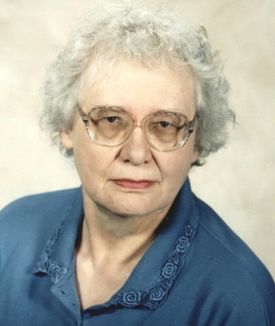
Publicity photo, 1999
Space is not the only topic of interest to me. More and more, in recent years, I’ve turned to ideas about human potential, especially in the area of “paranormal” capacities such as those portrayed in Enchantress from the Stars. Unlike most people as strongly science-oriented as I am, I have always believed that ESP is real, and that it’s been a much larger factor in human history than is recognized. I have never had psychic experiences myself; I’m much too “left-brained” for that—but I don’t doubt that other people do, and that in the future we’ll learn to control such powers. (Some of what I “made up” about them for Enchantress has been validated by recent nonfiction.) And we’ll also learn more about the relationship between mind and body. Human beings are far more than biological machines.
In this connection, and in accord with my usual tendency toward heretical views, I deplore the attitude fostered by our society’s medical philosophy, which I believe is based on false premises. I’ve devoted a good deal of thought and research to this issue; I once taught a Connect Ed media studies course on “Technology and 21st Century Medicine,” dealing with assumptions I feel will be abandoned. Not that I favor “natural” or “alternative” healing methods, with which I don’t agree either—unlike some today, I have no doubts about the benefits of high technology. Twice since moving to Eugene I have had major surgery for life-threatening conditions (which were quickly and completely cured) and I am thankful that this was available; modern medicine is very good at essential surgical repairs. But in most other respects, it’s apt to cause more problems than it solves, and worse, its conception of health has become a virtual religion to many, overshadowing all other scales of value. Some years ago I began an adult novel about a planet where the Medical Establishment had acquired dictatorial political power, which I still believe is a valid theme; but it lacked the key incidents needed to make a story. [They eventually came to me, and I published the novel, Stewards of the Flame, in 2007.]
It was the same old stumbling block—I’m no more action-oriented in my imagination than in real life. I can write about thoughts and feelings of characters, but I don’t visualize scenes in my mind as do most authors. Though I may know a desired plot outcome, I can’t think of events to bring it about. And I can no more force such material into consciousness than I could when I stopped producing fiction for Atheneum, despite my longing to do so and my enjoyment of the actual writing process. This is my greatest regret, and it is intensified by the frequent e-mails I receive that urge me to write another novel. People naturally believe that if I wanted to, I could. As if all I needed was encouragement! As if I hadn’t been frustrated for the past twenty years and more, wishing that it would again become possible for me!
To be sure, novels like mine, with the possible exception of more about Elana, would probably not be publishable today even if I could write them. Meisha Merlin publishes reprints and continuations of series; traditional publishers of adult fiction want books with bestseller potential, a situation affecting many authors with far greater past success than I. And “young adult” in recent years has meant books suitable for average middle school kids, not advanced readers or older teens (although there are signs that the pendulum is swinging back again). But if I had an idea for a story rather than a mere philosophical treatise—for readers of any age—I would not let lack of a publisher for it hold me back. I might even investigate electronic publishing, as I may in time for nonfiction; that’s a growing technology that may transform the way writers’ work is disseminated.
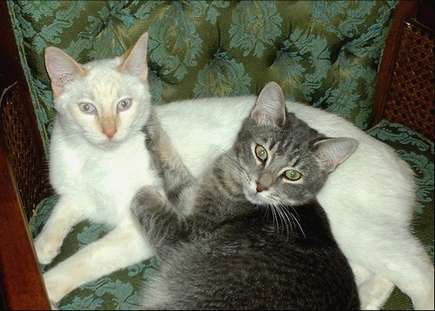
Gandalf the White and Dumbledore, 2002
It’s not my lack of energy that has kept me from writing more books. And it certainly isn’t lack of motivation. In the past, I resigned myself to the fact that except during one mysteriously atypical long-ago period, the creation of fiction was just not among my talents. But now, I feel I’m letting down the fans I’ve so recently discovered I have—and there’s no way to explain in a short e-mail reply that it isn’t by choice. People assume that proven writing ability is all it takes to produce a novel. If only that were true!
Lately, I’ve begun to be aware that I have less time ahead than I used to have for future work. Since I never had much youthful vigor at any age—at least not in the physical sense—growing older hasn’t changed my lifestyle; so it’s a bit startling to realize that now, I really am well along in years. Perhaps this will produce the urgency needed to bring my nonfiction projects to fruition. But it can’t change anything as far as new fiction is concerned. For that, I can only hope that someday the door to imaginative realms may once more open for me. It surprised me (and everyone who knew me) when it happened before … might I not, without warning, be surprised again?
Meanwhile, most of my past novels are back in print, in beautiful new editions. I know from the many e-mails I treasure that they’ve affected readers’ lives. And that’s much more enduring success than I ever anticipated.
*
Update (June 2017)
(This section does not appear in the published version.)
A lot has happened in my life since the preceding autobiography was published. The year I was seventy I obtained freelance work lasting for a decade, and like so many previous events that proved vital to my financial survival, that came about by chance. There is not enough freelance editing work that can be done entirely via the Internet to be found by applying for it; one must have contacts. (At least that was true until very recently, when the advent of independent publishing technology created a need for editors by indie authors.) I had no idea that any such work existed. But when in 2001 Gale asked me to update my autobiography and I scanned the original version for republication, it developed that they had a need for scanning—then a manual process—and proofreading of other authors’ autobiographies. Though this was a small amount of work, it put me in a position to be called upon in 2004 when they needed freelance copyeditors for several special-topic encyclopedias. And it placed my name in the database used by Greenhaven Press to find editors for its nonfiction anthology series.

Cover of one of the anthologes I edited
To begin with I worked on encyclopedia projects as well as on the selection of material for anthologies intended for high schools. Later I edited only the anthologies, sometimes eight or more per year. For the first time since leaving my programming job I was earning enough to live on—and more, as it enabled me to have major maintenance work done on my house and to save what I then believed would be sufficient to support me in old age. Furthermore, it was interesting work; I greatly enjoyed searching for articles suitable to reprint and organizing them into books that presented both sides of the controversial issues I was assigned to cover. During the ten years I did this, I produced fifty-nine such books. (They are listed at Amazon under my name; but readers should be aware that unlike the books I have written, they do not reveal my own opinions about the subjects with which they deal—the aim of the various series was to be impartial.) Unfortunately, in 2014 most of these series were discontinued and I have edited no more since then. But the income I earned between the ages of seventy and eighty made a huge difference in my financial well-being.
Much more than the opportunity to earn money happened during my seventies. Ironically, after twenty-five years of failing to produce a new novel, I began writing fiction again. Just when I was fully occupied with the freelance editing work, I got a story idea that enabled me to do so, and I found myself having to split my attention between them.
I suppose a major factor in the emergence of my unconscious inspiration for Stewards of the Flame and the books that followed was that I had given up trying to write a novel and had no current financial need, so I was no longer under pressure to come up with one. Significantly, I started writing Stewards just a few months after producing my first anthology, while I was busy with copyediting work; it was written in my spare time. For years I’d had nothing but spare time, and then everything came at once, perhaps because I’d stopped feeling that I ought be more productive.
My books have never fit the adult science fiction market. Being neither action/adventure fiction nor “far out” in terms of the culture and concepts portrayed, they generally appeal more to people who don't normally read science fiction than to avid sci-fi fans. So I knew while writing Stewards that it would not meet the requirements of any major science fiction publisher. It didn’t contain enough fast action to have mass-market potential. I thought it might be acceptable to the small press Meisha Merlin, which had just published Children of the Star, and in fact Meisha Merlin considered it for over a year, leading me to believe that they did want it. But then they went out of business, and though I had originally been inspired to write the book without hope of publication, I found that I couldn’t bear not to see it in print. And so I decided to publish it myself.

Original cover of Stewards of the Flame
At that time, self-publication was just becoming respectable and distinguishable from vanity publication. I now had professional copyediting experience and had done desktop publishing as a volunteer for several organizations, so I was able produce the files to be printed, including the cover, myself. It cost me only a license fee for the stock art and a small setup fee to the print-on-demand company (plus the much larger expense of review copies and advertising). And it was far more enjoyable for me than having to argue with an editor over wording and wait the year or more that normally passes between acceptance by a publisher and a book’s appearance.
Originally I didn’t plan to write a sequel to Stewards, but by the time it was published I’d become curious about what happened to characters later in their lives, and Promise of the Flame was well underway. I didn’t get the idea for Defender of the Flame until several years after that, and again, I had no intention of continuing the story; the inspiration for Herald of the Flame didn’t come to me until I had already issued Defender, calling it the conclusion of a trilogy. This was unfortunate because some of its early reviews call it that, although actually it begins an independent story.
Will I ever write another novel? Probably not; I have no ideas for a new story at present and since I’m already over eighty and all my past ones (apart from the continuation of existing series) have taken many years to incubate, there really isn’t enough time left to be inspired for another. Still, I have surprised myself before, and the question of whether there is a market for it no longer matters.
Today, of course, self-publishing—now known as indie publishing—is common, and is sometimes chosen even by authors of traditionally-published bestsellers. At the time Stewards came out there wasn’t any way independent authors could sell ebook editions other than at personal websites; now there are distributors, and hundreds of thousands of indie ebooks are offered by major retailers. I do not expect to make any significant amount of money from my indie books, even though in addition to my recent novels I have produced ebook editions—and some paperback editions—of my out-of-print YA novels. Unlike indie romance novels and thrillers, they sell very few copies, and since every year there are thousands more indie books for readers to choose from, the potential readership of any particular one can only decline. I publish not as a business, but because I want my books to be accessible.
Accessibility, however, does not mean that a book will become known to people likely to enjoy it; there are far too many now for anyone to browse through listings or online ads. So it’s almost impossible to find new readers, especially for books that are not typical of their genre and appeal most to those who aren’t looking for that genre. Since indie editions are rarely bought by libraries, they are most likely to be discovered through searching for the author by name, and I suppose no one searches for me when it’s assumed that I stopped writing decades ago. Yet as time goes on I am more and more frustrated by the fact that comparatively few adult fans of Enchantress from the Stars, or even of Children of the Star, have read my adult novels. Before I wrote those novels, I often received email from admirers of my previous books begging me to write another, but when I did, I received little feedback; and not enough copies, even of the inexpensive ebook editions, have been sold to account for more than a fraction of the people who praised my earlier ones. If the Flame duologies hadn’t gotten good reviews I’d assume they simply aren’t praiseworthy, but many reviewers’ enthusiastic comments suggest otherwise.

Cover of the paperback edition of Defender of the Flame
To be sure, Stewards of the Flame deals with issues that make some readers uncomfortable; I never expected everyone to like it. But enough reviewers did to make me wonder why it’s had so little notice from my existing fans. Perhaps, because it was necessary for me as a known YA author to emphasize in publicity that it’s not suitable for children, people thought I meant “adult” in the sense of X-rated—though I’d think readers familiar with my work would know me better than that. There’s some sex and profanity in all my adult novels, mild by today’s standards; but mainly it’s the controversial discussions of medical issues and of the relation between sex and telepathy—plus several incidents in Promise of the Flame—that I feel are inappropriate for readers younger than those who read other adult fiction. I don’t want the Flame duologies given to middle-school readers by librarians who assume anything by the author of Enchantress from the Stars must be okay for them.
Even among the people who did read Stewards, relatively few have gone on to the later books, which saddens me because many people like, or would like, the later ones better. It’s common for indie authors to make the ebook edition of the first novel in a series free, once sequels have appeared, in order to attract readers to them; but in my case this strategy has backfired—evidently the majority of people who downloaded Stewards were turned away by it. Yet the three later books don’t deal with the medical issues, and they also have more action of the kind expected in science fiction. They don’t depend on having read the first book, and in fact I now refer to the Flame novels as two duologies rather than a series because the third and fourth books are a separate story with different characters, set two centuries later than the first two. Moreover, they deal with several of the main themes of Enchantress from the Stars and The Far Side of Evil—not only with the development of psi powers, but with our world’s place in the universe. Adults who liked the ideas expressed in those books would therefore find them interesting. But so far, my efforts to get readers to start with the second duology haven’t been successful.
A major advantage of indie publication is that once included in an online ebook and/or print-on-demand catalog, a book will stay there permanently, even after the author’s death, whereas traditionally-published books go out of print, sometimes after mere months of availability. This is important to me. I like to think that although few people find them in any given year, over time their audience will grow.
*
Still another unanticipated change in my life happened six months ago, this one unwelcome. I had expected to stay in my home indefinitely, except perhaps for a short final illness; but it hasn’t worked out that way. In the fall of 2016, around the time of my eighty-third birthday, I began feeling weaker and realized that I might soon have to use a wheelchair most of the time rather than just on the rare occasions when I left the house. But a wheelchair large enough for me would not go through the narrow interior doors of my mobile home. Reluctantly I decided to sell it and move to a small retirement apartment where I would have independence, yet be provided with meals and housekeeping services.
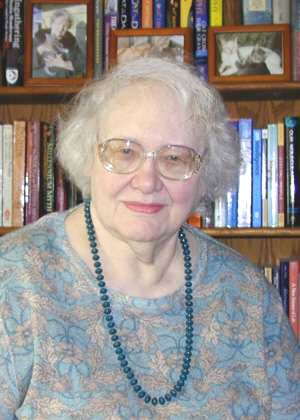
In my home at age seventy-three, 2007
During the last weeks before the planned move, I became still weaker, to a much greater extent than could be explained by my age alone. I could barely get around even with my walker; I felt as if my legs would collapse. And finally one night they did collapse—I had to call the paramedics to pick me up and take me to the hospital. I have not stood up since, except for a few seconds at a time, with help, to transfer between my bed and a wheelchair. It took three months in rehab to gain even that much mobility, and the cause of my legs’ sudden weakness remains unknown.
After long delays arranging via email to dispose of my furniture and other belongings and get my house cleaned out so that it could be put on the market, followed by more delay finding a buyer, it has finally been sold. I now live in a single room in a residential care facility, leaving it only via a wheelchair for meals and showers. While it’s a nice room with a view of trees from the window, the prospect of spending the rest of my life in it seems rather daunting.
But I still have my desktop computer, with which I spent most of my time anyway, and my laptop, which I use when lying down. And I still have access to the Internet. So I’m in as close touch with the world as I ever was. That is the miracle of computer technology—no one today need be isolated, regardless of physical disability. Computers have been my salvation from youth, when by chance I was hired as a programmer, until old age, when without them my productive life would end. What has happened to me is not the disaster it would have been a generation ago. I was born in the right era, and in that, as with so many of my life's turning points, I have been favored by fate.
Copyright 1988, 2001 by Gale; update section 2017 by Sylvia Engdahl
All rights reserved.
This essay is included in my ebook Reflections on Enchantress from the Stars and Other Essays
From My Photo Albums
All my life have enjoyed taking pictures and putting them in albums. When I moved to assisted living I scanned thousands of album pages and have since had fun creating small topical pdf albums of the best ones. And it saddens me to know that these will be gone when my hard discs and flash drives are destroyed at the time of my death. I have no family to leave them to. All memory of people and places in my life will be gone. It's not that I think anyone will be interested in them, except in the sense of curiosity about how people lived in the second half of the 20th century; I just can't bear the idea of the record ceasfng to exist. So I'm putting some of them at my website, which will be preserved as long as copies of my books are kept available at retail outlrts.
Most of the pictures are scenic ones taken during my travels; they can be accessed from the Miscellany tab in the nvigation bar. There are also albums on the pages for my mother and my cats. Here below are the more personal ones skowing, among other things, the many houses in which i lived and the views from them. Unless you have a large monitor, they look best if you zoom until two horizontal pictures side by side fill the screen and scroll to see the next row. Use your browser's back button to return to this list after viewng a topic.
Homes I Lived In, 1934-1962 (Not counting apartments)
Homes I Owned, 1962-2016 (Shared with my mother)
My Home for 30 Years (Manufactured home, moved during 2nd year)
My Bedrooms and Studies (In eight houses)
Views from Places I've Lived (Mt. Hood, the ocean, and more)
Cars I Owned (Plus my parents' cars)
Relatives (For my mother, see her memorial page.)
Best Pictures of Me (Including childhood)